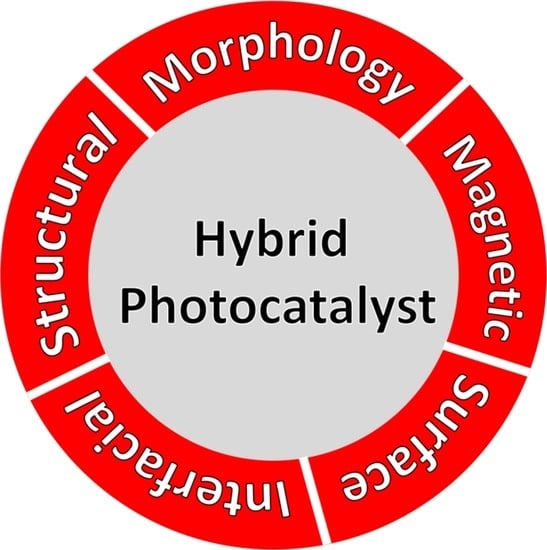Emerging Hybrid Nanocomposite Photocatalysts for the Degradation of Antibiotics: Insights into Their Designs and Mechanisms
Abstract
1. Introduction
2. Photocatalysis: An Overview
3. Hybrid Photocatalysts: An Overview
3.1. Bismuth Hybrids
3.2. Cadmium Hybrids
3.3. Calcium Hybrids
3.4. Cerium Hybrids
3.5. Cobalt Hybrids
3.6. Copper Hybrids
3.7. Graphitic Carbon Nitride Hybrids
3.8. Indium Hybrids
3.9. Iron Hybrids
3.10. Lanthanum Hybrids
3.11. Lead Hybrids
3.12. Manganese Hybrids
3.13. Molybdenum Hybrids
3.14. Nickel Hybrids
3.15. Silver Hybrids
3.16. Strontium Hybrids
3.17. Tin Hybrids
3.18. Titanium Hybrids
3.19. Tungsten Hybrids
3.20. Zinc Hybrids
4. Conclusions
Author Contributions
Funding
Conflicts of Interest
References
- Kuster, A.; Adler, N. Pharmaceuticals in the environment: Scientific evidence of risks and its regulation. Philos. Trans. R. Soc. Lond. Ser. B 2014, 369, 20130587. [Google Scholar] [CrossRef]
- Khetan, S.K.; Collins, T.J. Human pharmaceuticals in the aquatic environment: A challenge to green chemistry. Chem. Rev. 2007, 107, 2319–2364. [Google Scholar] [CrossRef]
- Patel, M.; Kumar, R.; Kishor, K.; Mlsna, T.; Pittman Jr, C.U.; Mohan, D. Pharmaceuticals of emerging concern in aquatic systems: Chemistry, occurrence, effects, and removal methods. Chem. Rev. 2019, 119, 3510–3673. [Google Scholar] [CrossRef]
- Aus der Beek, T.; Weber, F.A.; Bergmann, A.; Hickmann, S.; Ebert, I.; Hein, A.; Küster, A. Pharmaceuticals in the environment-global occurrences and perspectives. Environ. Toxicol. Chem. 2016, 35, 823–835. [Google Scholar] [CrossRef]
- Martínez, J.L. Antibiotics and antibiotic resistance genes in natural environments. Science 2008, 321, 365–367. [Google Scholar] [CrossRef]
- De Kraker, M.E.; Stewardson, A.J.; Harbarth, S. Will 10 million people die a year due to antimicrobial resistance by 2050? PLoS Med. 2016, 13, e1002184. [Google Scholar] [CrossRef] [PubMed]
- Homem, V.; Santos, L. Degradation and removal methods of antibiotics from aqueous matrices—A review. J. Environ. Manag. 2011, 92, 2304–2347. [Google Scholar] [CrossRef]
- Gadipelly, C.; Perez-Gonzalez, A.; Yadav, G.D.; Ortiz, I.; Ibanez, R.; Rathod, V.K.; Marathe, K.V. Pharmaceutical industry wastewater: Review of the technologies for water treatment and reuse. Ind. Eng. Chem. Res. 2014, 53, 11571–11592. [Google Scholar] [CrossRef]
- Calvete, M.J.; Piccirillo, G.; Vinagreiro, C.S.; Pereira, M.M. Hybrid materials for heterogeneous photocatalytic degradation of antibiotics. Coord. Chem. Rev. 2019, 395, 63–85. [Google Scholar] [CrossRef]
- Rokesh, K.; Sakar, M.; Do, T.-O. Calcium bismuthate (CaBiO3): Apotential sunlight-driven perovskite photocatalyst for the degradation of emerging pharmaceutical contaminants. ChemPhotoChem 2020, 4, 373–380. [Google Scholar] [CrossRef]
- Bagheri, S.; TermehYousefi, A.; Do, T.-O. Photocatalytic pathway toward degradation of environmental pharmaceutical pollutants: Structure, kinetics and mechanism approach. Catal. Sci. Technol. 2017, 7, 4548–4569. [Google Scholar] [CrossRef]
- Nguyen, C.-C.; Nguyen, D.T.; Do, T.-O. A novel route to synthesize C/Pt/TiO2 phase tunable anatase-rutile TiO2 for efficient sunlight-driven photocatalytic applications. Appl. Catal. B 2018, 226, 46–52. [Google Scholar] [CrossRef]
- Nguyen, C.C.; Vu, N.N.; Chabot, S.; Kaliaguine, S.; Do, T.O. Role of CxNy-triazine in photocatalysis for efficient hydrogen generation and organic pollutant degradation under solarlight irradiation. Sol. RRL 2017, 1, 1700012. [Google Scholar] [CrossRef]
- Ajmal, A.; Majeed, I.; Malik, R.N.; Idriss, H.; Nadeem, M.A. Principles and mechanisms of photocatalytic dye degradation on TiO2 based photocatalysts: A comparative overview. RSC Adv. 2014, 4, 37003–37026. [Google Scholar] [CrossRef]
- Do, T.-O.; Mohan, S. Editorial: Special issue on “emerging trends in TiO2 photocatalysis and applications”. Catalysts 2020, 10, 670. [Google Scholar] [CrossRef]
- Sakar, M.; Nguyen, C.-C.; Vu, M.-H.; Do, T.-O. Materials and mechanisms of photo-assisted chemical reactions under light and dark conditions: Can day-night photocatalysis be achieved? ChemSusChem 2018, 11, 809–820. [Google Scholar] [CrossRef] [PubMed]
- Sarkar, S.; Das, R.; Choi, H.; Bhattacharjee, C. Involvement of process parameters and various modes of application of TiO2 nanoparticles in heterogeneous photocatalysis of pharmaceutical wastes-a short review. RSC Adv. 2014, 4, 57250–57266. [Google Scholar] [CrossRef]
- Sakar, M.; Mithun Prakash, R.; Do, T.-O. Insights into the TiO2-based photocatalytic systems and their mechanisms. Catalysts 2019, 9, 680. [Google Scholar] [CrossRef]
- Hoffmann, M.R.; Martin, S.T.; Choi, W.; Bahnemann, D.W. Environmental applications of semiconductor photocatalysis. Chem. Rev. 1995, 95, 69–96. [Google Scholar] [CrossRef]
- Sakar, M.; Balakumar, S.; Saravanan, P.; Bharathkumar, S. Particulates vs. fibers: Dimension featured magnetic and visible light driven photocatalytic properties of Sc modified multiferroic bismuth ferrite nanostructures. Nanoscale 2016, 8, 1147–1160. [Google Scholar] [CrossRef]
- Mokhtarifar, M.; Nguyen, D.-T.; Diamanti, M.V.; Kaveh, R.; Asa, M.; Mohan, S.; Pedeferri, M.; Do, T.-O. Fabrication of dual-phase TiO2/WO3 with post-illumination photocatalytic memory. New J. Chem. 2020, 44, 20375–20386. [Google Scholar] [CrossRef]
- Nguyen, C.-C.; Dinh, C.-T.; Do, T.-O. Hollow Sr/Rh-codoped TiO2 photocatalyst for efficient sunlight-driven organic compound degradation. RSC Adv. 2017, 7, 3480–3487. [Google Scholar] [CrossRef][Green Version]
- Nguyen, C.-C.; Vu, N.-N.; Do, T.-O. Efficient hollow double-shell photocatalysts for the degradation of organic pollutants under visible light and in darkness. J. Mater. Chem. A 2016, 4, 4413–4419. [Google Scholar] [CrossRef]
- Nguyen, C.C.; Vu, N.N.; Do, T.-O. Recent advances in the development of sunlight-driven hollow structure photocatalysts and their applications. J. Mater. Chem. A 2015, 3, 18345–18359. [Google Scholar] [CrossRef]
- Nguyen, D.-T.; Nguyen, C.-C.; St-Jean, M.; Chabot, S.p.; Kaliaguine, S.; Do, T.-O. All in One: Contributions of Ni dopants and Ni/NiS dual cocatalysts to the enhanced efficiency of TiO2photocatalyst for the degradation of organic pollutants. ACS Appl. Nano Mater. 2018, 1, 6864–6873. [Google Scholar] [CrossRef]
- Dinh, C.-T.; Nguyen, T.-D.; Kleitz, F.; Do, T.-O. A new route to size and population control of silver clusters on colloidal TiO2 nanocrystals. ACS Appl. Mater. Interfaces 2011, 3, 2228–2234. [Google Scholar] [CrossRef]
- Wang, F.; Li, Q.; Xu, D. Recent progress in semiconductor-based nanocomposite photocatalysts for solar-to-chemical energy conversion. Adv. Energy Mater. 2017, 7, 1700529. [Google Scholar] [CrossRef]
- Xu, C.; Anusuyadevi, P.R.; Aymonier, C.; Luque, R.; Marre, S. Nanostructured materials for photocatalysis. Chem. Soc. Rev. 2019, 48, 3868–3902. [Google Scholar] [CrossRef] [PubMed]
- Sakar, M.; Balakumar, S. Reverse Ostwald ripening process induced dispersion of Cu2O nanoparticles in silver-matrix and their interfacial mechanism mediated sunlight driven photocatalytic properties. J. Photochem. Photobiol. A 2018, 356, 150–158. [Google Scholar] [CrossRef]
- Mohan, S.; Subramanian, B.; Sarveswaran, G. A prototypical development of plasmonic multiferroic bismuth ferrite particulate and fiber nanostructures and their remarkable photocatalytic activity under sunlight. J. Mater. Chem. C 2014, 2, 6835–6842. [Google Scholar] [CrossRef]
- Zhou, C.; Lai, C.; Xu, P.; Zeng, G.; Huang, D.; Zhang, C.; Cheng, M.; Hu, L.; Wan, J.; Liu, Y. In situ grown AgI/Bi12O17Cl2 heterojunction photocatalysts for visible light degradation of sulfamethazine: Efficiency, pathway, and mechanism. ACS Sustain. Chem. Eng. 2018, 6, 4174–4184. [Google Scholar] [CrossRef]
- Guo, H.; Niu, C.-G.; Zhang, L.; Wen, X.-J.; Liang, C.; Zhang, X.-G.; Guan, D.-L.; Tang, N.; Zeng, G.-M. Construction of direct Z-scheme AgI/Bi2Sn2O7 nanojunction system with enhanced photocatalytic activity: Accelerated interfacial charge transfer induced efficient Cr(VI) reduction, tetracycline degradation and Escherichia coli inactivation. ACS Sustain. Chem. Eng. 2018, 6, 8003–8018. [Google Scholar] [CrossRef]
- Zhang, Z.; Pan, Z.; Guo, Y.; Wong, P.K.; Zhou, X.; Bai, R. In-situ growth of all-solid Z-scheme heterojunction photocatalyst of Bi7O9I3/g-C3N4 and high efficient degradation of antibiotic under visible light. Appl. Catal. B 2020, 261, 118212. [Google Scholar] [CrossRef]
- Shi, Z.; Zhang, Y.; Liu, T.; Cao, W.; Zhang, L.; Li, M.; Chen, Z. Synthesis of BiOBr/Ag3PO4 heterojunctions on carbon-fiber cloth as filter-membrane-shaped photocatalyst for treating the flowing antibiotic wastewater. J. Colloid Interface Sci. 2020, 575, 183–193. [Google Scholar] [CrossRef] [PubMed]
- Wang, K.; Li, Y.; Zhang, G.; Li, J.; Wu, X. 0D Bi nanodots/2D Bi3NbO7 nanosheets heterojunctions for efficient visible light photocatalytic degradation of antibiotics: Enhanced molecular oxygen activation and mechanism insight. Appl. Catal. B 2019, 240, 39–49. [Google Scholar] [CrossRef]
- Qian, K.; Xia, L.; Jiang, Z.; Wei, W.; Chen, L.; Xie, J. In situ chemical transformation synthesis of Bi4Ti3O12/I-BiOCl 2D/2D heterojunction systems for water pollution treatment and hydrogen production. Catal. Sci. Technol. 2017, 7, 3863–3875. [Google Scholar] [CrossRef]
- Zhou, C.; Lai, C.; Xu, P.; Zeng, G.; Huang, D.; Li, Z.; Zhang, C.; Cheng, M.; Hu, L.; Wan, J. Rational design of carbon-doped carbon nitride/Bi12O17Cl2 composites: A promising candidate photocatalyst for boosting visible-light-driven photocatalytic degradation of tetracycline. ACS Sustain. Chem. Eng. 2018, 6, 6941–6949. [Google Scholar] [CrossRef]
- Jahurul Islam, M.; Kim, H.K.; Amaranatha Reddy, D.; Kim, Y.; Ma, R.; Baek, H.; Kim, J.; Kim, T.K. Hierarchical BiOI nanostructures supported on a metal organic framework as efficient photocatalysts for degradation of organic pollutants in water. Dalton Trans. 2017, 46, 6013–6023. [Google Scholar] [CrossRef]
- Zhu, S.-R.; Qi, Q.; Fang, Y.; Zhao, W.-N.; Wu, M.-K.; Han, L. Covalent triazine framework modified BiOBr nanoflake with enhanced photocatalytic activity for antibiotic removal. Cryst. Growth Des. 2018, 18, 883–891. [Google Scholar] [CrossRef]
- Lv, T.; Li, D.; Hong, Y.; Luo, B.; Xu, D.; Chen, M.; Shi, W. Facile synthesis of CdS/Bi4V2O11 photocatalysts with enhanced visible-light photocatalytic activity for degradation of organic pollutants in water. Dalton Trans. 2017, 46, 12675–12682. [Google Scholar] [CrossRef]
- Zhang, L.; Niu, C.-G.; Liang, C.; Wen, X.-J.; Huang, D.-W.; Guo, H.; Zhao, X.-F.; Zeng, G.-M. One-step in situ synthesis of CdS/SnO2 heterostructure with excellent photocatalytic performance for Cr(VI) reduction and tetracycline degradation. Chem. Eng. J. 2018, 352, 863–875. [Google Scholar] [CrossRef]
- Cao, H.-L.; Cai, F.-Y.; Yu, K.; Zhang, Y.-Q.; Lu, J.; Cao, R. Photocatalytic degradation of tetracycline antibiotics over CdS/nitrogen-doped-carbon composites derived from in situ carbonization of metal-organic frameworks(MOFs). ACS Sustain. Chem. Eng. 2019, 7, 10847–10854. [Google Scholar] [CrossRef]
- Jiang, Y.; Peng, Z.; Wu, F.; Xiao, Y.; Jing, X.; Wang, L.; Liu, Z.; Zhang, J.; Liu, Y.; Ni, L. A novel 3D/2D CdIn2S4 nano-octahedron/ZnO nanosheet heterostructure: Facile synthesis, synergistic effect and enhanced tetracycline hydrochloride photodegradation mechanism. Dalton Trans. 2018, 47, 8724–8737. [Google Scholar] [CrossRef]
- Li, M.; Bai, H.Y.; Da, Z.L.; Yan, X.; Chen, C.; Jiang, J.H.; Fan, W.Q.; Shi, W.D. Electrospinning synthesis and photocatalytic property of CaFe2O4/MgFe2O4 heterostructure for degradation of tetracycline. Cryst. Res. Technol. 2015, 50, 244–249. [Google Scholar] [CrossRef]
- Behera, A.; Kandi, D.; Sahoo, S.; Parida, K. Construction of isoenergetic band alignment between CdS QDs and CaFe2O4@ZnFe2O4 heterojunction: A promising ternary hybrid toward norfloxacin degradation and H2 energy production. J. Phys. Chem. C 2019, 123, 17112–17126. [Google Scholar] [CrossRef]
- Zhang, X.; Huang, J.; Kang, Z.; Yang, D.-P.; Luque, R. Eggshell-templated synthesis of PbS/CaCO3nanocomposites for CO3− mediated efficient degradation of tetracycline under solar light irradiation. Mol. Catal. 2020, 484, 110786. [Google Scholar] [CrossRef]
- Guan, J.; Li, J.; Ye, Z.; Wu, D.; Liu, C.; Wang, H.; Ma, C.; Huo, P.; Yan, Y. La2O3 media enhanced electrons transfer for improved CeVO4@halloysite nanotubes photocatalytic activity for removing tetracycline. J. Taiwan Inst. Chem. Eng. 2019, 96, 281–298. [Google Scholar] [CrossRef]
- Wen, X.-J.; Niu, C.-G.; Zhang, L.; Liang, C.; Zeng, G.-M. A novel Ag2O/CeO2 heterojunction photocatalysts for photocatalytic degradation of enrofloxacin: Possible degradation pathways, mineralization activity and an in depth mechanism insight. Appl. Catal. B 2018, 221, 701–714. [Google Scholar] [CrossRef]
- Karthik, R.; Vinoth Kumar, J.; Chen, S.-M.; Karuppiah, C.; Cheng, Y.-H.; Muthuraj, V. A study of electrocatalytic and photocatalytic activity of cerium molybdate nanocubes decorated graphene oxide for the sensing and degradation of antibiotic drug chloramphenicol. ACS Appl. Mater. Interfaces 2017, 9, 6547–6559. [Google Scholar] [CrossRef] [PubMed]
- Mansingh, S.; Acharya, R.; Martha, S.; Parida, K. Pyrochlore Ce2Zr2O7 decorated over rGO: A photocatalyst that proves to be efficient towards the reduction of 4-nitrophenol and degradation of ciprofloxacin under visible light. Phys. Chem. Chem. Phys. 2018, 20, 9872–9885. [Google Scholar] [CrossRef] [PubMed]
- Lu, Z.; Yu, Z.; Dong, J.; Song, M.; Liu, Y.; Liu, X.; Fan, D.; Ma, Z.; Yan, Y.; Huo, P. Construction of stable core-shell imprinted Ag-(poly-o-phenylenediamine)/CoFe2O4 photocatalyst endowed with the specific recognition capability for selective photodegradation of ciprofloxacin. RSC Adv. 2017, 7, 48894–48903. [Google Scholar] [CrossRef]
- He, F.; Lu, Z.; Song, M.; Liu, X.; Tang, H.; Huo, P.; Fan, W.; Dong, H.; Wu, X.; Han, S. Selective reduction of Cu2+ with simultaneous degradation of tetracycline by the dual channels ion imprinted POPD-CoFe2O4 heterojunction photocatalyst. Chem. Eng. J. 2019, 360, 750–761. [Google Scholar] [CrossRef]
- Kamranifar, M.; Allahresani, A.; Naghizadeh, A. Synthesis and characterizations of a novel CoFe2O4@CuS magnetic nanocomposite and investigation of its efficiency for photocatalytic degradation of penicillin G antibiotic in simulated wastewater. J. Hazard. Mater. 2019, 366, 545–555. [Google Scholar] [CrossRef]
- Ma, W.; Chen, L.; Dai, J.; Li, C.; Yan, Y. Magnetic Co0.5Zn0.5FeO4 nanoparticle-modified polymeric g-C3N4 sheets with enhanced photocatalytic performance for chloromycetin degradation. RSC Adv. 2016, 6, 48875–48883. [Google Scholar] [CrossRef]
- Zheng, J.; Zhang, L. Rational design and fabrication of multifunctional catalyzer Co2SnO4-SnO2/GC for catalysis applications: Photocatalytic degradation/catalytic reduction of organic pollutants. Appl. Catal. B 2018, 231, 34–42. [Google Scholar] [CrossRef]
- Lei, X.; Cao, Y.; Chen, Q.; Ao, X.; Fang, Y.; Liu, B. ZIF-8 derived hollow CuO/ZnO material for study of enhanced photocatalytic performance. Colloids Surf. A 2019, 568, 1–10. [Google Scholar] [CrossRef]
- Zheng, X.; Mao, Y.; Wen, J.; Fu, X.; Liu, X. CuInS2/Mg(OH)2 nanosheets for the enhanced visible-light photocatalytic degradation of tetracycline. Nanomaterials 2019, 9, 1567. [Google Scholar] [CrossRef]
- Lu, X.; Che, W.; Hu, X.; Wang, Y.; Zhang, A.; Deng, F.; Luo, S.; Dionysiou, D.D. The facile fabrication of novel visible-light-driven Z-scheme CuInS2/Bi2WO6 heterojunction with intimate interface contact by in situ hydrothermal growth strategy for extraordinary photocatalytic performance. Chem. Eng. J. 2019, 356, 819–829. [Google Scholar] [CrossRef]
- Guo, F.; Shi, W.; Wang, H.; Han, M.; Guan, W.; Huang, H.; Liu, Y.; Kang, Z. Study on highly enhanced photocatalytic tetracycline degradation of type Ⅱ AgI/CuBi2O4 and Z-scheme AgBr/CuBi2O4 heterojunction photocatalysts. J. Hazard. Mater. 2018, 349, 111–118. [Google Scholar] [CrossRef]
- Yang, J.; Li, Z.; Zhu, H. Adsorption and photocatalytic degradation of sulfamethoxazole by a novel composite hydrogel with visible light irradiation. Appl. Catal. B 2017, 217, 603–614. [Google Scholar] [CrossRef]
- Gao, Y.; Wu, J.; Wang, J.; Fan, Y.; Zhang, S.; Dai, W. A novel multifunctional p-type semiconductor@MOFs nanoporous platform for simultaneous sensing and photodegradation of tetracycline. ACS Appl. Mater. Interfaces 2020, 12, 11036–11044. [Google Scholar] [CrossRef]
- Lu, X.; Jin, Y.; Zhang, X.; Xu, G.; Wang, D.; Lv, J.; Zheng, Z.; Wu, Y. Controllable synthesis of graphitic C3N4/ultrathin MoS2 nanosheet hybrid nanostructures with enhanced photocatalytic performance. Dalton Trans. 2016, 45, 15406–15414. [Google Scholar] [CrossRef]
- Mirzaei, A.; Chen, Z.; Haghighat, F.; Yerushalmi, L. Magnetic fluorinated mesoporous g-C3N4 for photocatalytic degradation of amoxicillin: Transformation mechanism and toxicity assessment. Appl. Catal. B 2019, 242, 337–348. [Google Scholar] [CrossRef]
- Chouchene, B.; Gries, T.; Balan, L.; Medjahdi, G.; Schneider, R. Graphitic carbon nitride/SmFeO3 composite Z-scheme photocatalyst with high visible light activity. Nanotechnology 2020, 31, 465704. [Google Scholar] [CrossRef]
- Qin, D.; Lu, W.; Wang, X.; Li, N.; Chen, X.; Zhu, Z.; Chen, W. Graphitic carbon nitride from burial to re-emergence on polyethylene terephthalate nanofibers as an easily recycled photocatalyst for degrading antibiotics under solar irradiation. ACS Appl. Mater. Interfaces 2016, 8, 25962–25970. [Google Scholar] [CrossRef]
- Jiang, L.; Yuan, X.; Zeng, G.; Wu, Z.; Liang, J.; Chen, X.; Leng, L.; Wang, H.; Wang, H. Metal-free efficient photocatalyst for stable visible-light photocatalytic degradation of refractory pollutant. Appl. Catal. B 2018, 221, 715–725. [Google Scholar] [CrossRef]
- Xu, T.; Wang, D.; Dong, L.; Shen, H.; Lu, W.; Chen, W. Graphitic carbon nitride co-modified by zinc phthalocyanine and graphene quantum dots for the efficient photocatalytic degradation of refractory contaminants. Appl. Catal. B 2019, 244, 96–106. [Google Scholar] [CrossRef]
- Abazari, R.; Mahjoub, A.R.; Sanati, S.; Rezvani, Z.; Hou, Z.; Dai, H. Ni-Ti layered double hydroxide@graphitic carbon nitride nanosheet: A novel nanocomposite with high and ultrafast sonophotocatalytic performance for degradation of antibiotics. Inorg. Chem. 2019, 58, 1834–1849. [Google Scholar] [CrossRef]
- Panneri, S.; Thomas, M.; Ganguly, P.; Nair, B.N.; Mohamed, A.P.; Warrier, K.; Hareesh, U. C3N4 anchored ZIF8 composites: Photo-regenerable, high capacity sorbents as adsorptive photocatalysts for the effective removal of tetracycline from water. Catal. Sci. Technol. 2017, 7, 2118–2128. [Google Scholar] [CrossRef]
- Yuan, D.; Ding, J.; Zhou, J.; Wang, L.; Wan, H.; Dai, W.-L.; Guan, G. Graphite carbon nitride nanosheets decorated with ZIF-8 nanoparticles: Effects of the preparation method and their special hybrid structures on the photocatalytic performance. J. Alloys Compd. 2018, 762, 98–108. [Google Scholar] [CrossRef]
- Zhang, M.; Hou, Z.; Ma, W.; Zhao, X.; Ma, C.; Zhu, Z.; Yan, Y.; Li, C. Fabrication of a visible-light In2S3/BiPO4 heterojunction with enhanced photocatalytic activity. New J. Chem. 2018, 42, 15136–15145. [Google Scholar] [CrossRef]
- Yuan, X.; Jiang, L.; Liang, J.; Pan, Y.; Zhang, J.; Wang, H.; Leng, L.; Wu, Z.; Guan, R.; Zeng, G. In-situ synthesis of 3D microsphere-like In2S3/InVO4 heterojunction with efficient photocatalytic activity for tetracycline degradation under visible light irradiation. Chem. Eng. J. 2019, 356, 371–381. [Google Scholar] [CrossRef]
- Xu, J.; Luo, B.; Gu, W.; Jian, Y.; Wu, F.; Tang, Y.; Shen, H. Fabrication of In2S3/NaTaO3 composites for enhancing the photocatalytic activity toward the degradation of tetracycline. New J. Chem. 2018, 42, 5052–5058. [Google Scholar] [CrossRef]
- Meng, Y.; Hong, Y.; Huang, C.; Shi, W. Fabrication of novel Z-scheme InVO4/CdS heterojunctions with efficiently enhanced visible light photocatalytic activity. CrystEngComm 2017, 19, 982–993. [Google Scholar] [CrossRef]
- Ren, L.; Zhou, W.; Sun, B.; Li, H.; Qiao, P.; Xu, Y.; Wu, J.; Lin, K.; Fu, H. Defects-engineering of magnetic γ-Fe2O3 ultrathin nanosheets/mesoporous black TiO2 hollow sphere heterojunctions for efficient charge separation and the solar-driven photocatalytic mechanism of tetracycline degradation. Appl. Catal. B 2019, 240, 319–328. [Google Scholar] [CrossRef]
- Du, D.; Shi, W.; Wang, L.; Zhang, J. Yolk-shell structured Fe3O4@void@TiO2 as a photo-Fenton-like catalyst for the extremely efficient elimination of tetracycline. Appl. Catal. B 2017, 200, 484–492. [Google Scholar] [CrossRef]
- Wang, W.; Xiao, K.; Zhu, L.; Yin, Y.; Wang, Z. Graphene oxide supported titanium dioxide & ferroferric oxide hybrid, a magnetically separable photocatalyst with enhanced photocatalytic activity for tetracycline hydrochloride degradation. RSC Adv. 2017, 7, 21287–21297. [Google Scholar]
- Shooshtari, N.M.; Ghazi, M.M. An investigation of the photocatalytic activity of nano α-Fe2O3/ZnO on the photodegradation of cefixime trihydrate. Chem. Eng. J. 2017, 315, 527–536. [Google Scholar] [CrossRef]
- Lu, Z.; Zhao, X.; Zhu, Z.; Song, M.; Gao, N.; Wang, Y.; Ma, Z.; Shi, W.; Yan, Y.; Dong, H. A novel hollow capsule-like recyclable functional ZnO/C/Fe3O4 endowed with three-dimensional oriented recognition ability for selectively photodegrading danofloxacin mesylate. Catal. Sci. Technol. 2016, 6, 6513–6524. [Google Scholar] [CrossRef]
- Li, J.; Han, M.; Guo, Y.; Wang, F.; Sun, C. Fabrication of FeVO4/Fe2TiO5 composite catalyst and photocatalytic removal of norfloxacin. Chem. Eng. J. 2016, 298, 300–308. [Google Scholar] [CrossRef]
- Zhou, Z.; Xu, H.; Li, D.; Zou, Z.; Xia, D. Microwave-assisted synthesis of La(OH)3/BiOCl nn heterojunctions with high oxygen vacancies and its enhanced photocatalytic properties. Chem. Phys. Lett. 2019, 736, 136805. [Google Scholar] [CrossRef]
- Wang, B.; Wei, K.; Chen, F.; Wang, Y.; He, G.; Li, W.; Liu, J.; He, Q. Effects of active species on degrading A-ring of tetracycline in the Z-scheme heterostructured core-shell La(OH)3@BaTiO3 composition. J. Alloys Compd. 2019, 804, 100–110. [Google Scholar] [CrossRef]
- Zhou, X.; Chen, Y.; Li, C.; Zhang, L.; Zhang, X.; Ning, X.; Zhan, L.; Luo, J. Construction of LaNiO3 nanoparticles modified g-C3N4 nanosheets for enhancing visible light photocatalytic activity towards tetracycline degradation. Sep. Purif. Technol. 2019, 211, 179–188. [Google Scholar] [CrossRef]
- Yao, S.; Wu, J.; Li, W.; Zheng, R.; Li, R.; Chen, Y.; Luo, J.; Zhou, X. LaCoO3 co-catalyst modified Ag2CrO4 for improved visible-light-driven photocatalytic degradation of tetracycline. Sep. Purif. Technol. 2019, 227, 115691. [Google Scholar] [CrossRef]
- Xu, Y.; Liu, J.; Xie, M.; Jing, L.; Xu, H.; She, X.; Li, H.; Xie, J. Construction of novel CNT/LaVO4 nanostructures for efficient antibiotic photodegradation. Chem. Eng. J. 2019, 357, 487–497. [Google Scholar] [CrossRef]
- Samy, M.; Ibrahim, M.G.; Alalm, M.G.; Fujii, M. Effective photocatalytic degradation of sulfamethazine by CNTs/LaVO4 in suspension and dip coating modes. Sep. Purif. Technol. 2020, 235, 116138. [Google Scholar] [CrossRef]
- Wang, B.; Liu, G.; Ye, B.; Ye, Y.; Zhu, W.; Yin, S.; Xia, J.; Li, H. Novel CNT/PbBiO2Br hybrid materials with enhanced broad spectrum photocatalytic activity toward ciprofloxacin (CIP) degradation. J. Photochem. Photobiol. A 2019, 382, 111901. [Google Scholar] [CrossRef]
- Li, M.; Yin, S.; Wu, T.; Di, J.; Ji, M.; Wang, B.; Chen, Y.; Xia, J.; Li, H. Controlled preparation of MoS2/PbBiO2I hybrid microspheres with enhanced visible-light photocatalytic behaviour. J. Colloid Interface Sci. 2018, 517, 278–287. [Google Scholar] [CrossRef]
- Azimi, S.; Nezamzadeh-Ejhieh, A. Enhanced activity of clinoptilolite-supported hybridized Pb-CdS semiconductors for the photocatalytic degradation of a mixture of tetracycline and cephalexin aqueous solution. J. Mol. Catal. A Chem. 2015, 408, 152–160. [Google Scholar] [CrossRef]
- Guo, H.; Niu, C.-G.; Huang, D.-W.; Tang, N.; Liang, C.; Zhang, L.; Wen, X.-J.; Yang, Y.; Wang, W.-J.; Zeng, G.-M. Integrating the plasmonic effect and pn heterojunction into a novel Ag/Ag2O/PbBiO2Br photocatalyst: Broadened light absorption and accelerated charge separation co-mediated highly efficient visible/NIR light photocatalysis. Chem. Eng. J. 2019, 360, 349–363. [Google Scholar] [CrossRef]
- Gupta, V.K.; Fakhri, A.; Agarwal, S.; Ahmadi, E.; Nejad, P.A. Synthesis and characterization of MnO2/NiO nanocomposites for photocatalysis of tetracycline antibiotic and modification with guanidine for carriers of caffeic acid phenethyl ester-an anticancer drug. J. Photochem. Photobiol. B 2017, 174, 235–242. [Google Scholar] [CrossRef]
- Chen, W.; He, Z.-C.; Huang, G.-B.; Wu, C.-L.; Chen, W.-F.; Liu, X.-H. Direct Z-scheme 2D/2D MnIn2S4/g-C3N4 architectures with highly efficient photocatalytic activities towards treatment of pharmaceutical wastewater and hydrogen evolution. Chem. Eng. J. 2019, 359, 244–253. [Google Scholar] [CrossRef]
- Gautam, S.; Shandilya, P.; Priya, B.; Singh, V.P.; Raizada, P.; Rai, R.; Valente, M.; Singh, P. Superparamagnetic MnFe2O4 dispersed over graphitic carbon sand composite and bentonite as magnetically recoverable photocatalyst for antibiotic mineralization. Sep. Purif. Technol. 2017, 172, 498–511. [Google Scholar] [CrossRef]
- Wang, X.; Wang, A.; Ma, J. Visible-light-driven photocatalytic removal of antibiotics by newly designed C3N4@MnFe2O4-graphene nanocomposites. J. Hazard. Mater. 2017, 336, 81–92. [Google Scholar] [CrossRef]
- Zhao, J.; Zhao, Z.; Li, N.; Nan, J.; Yu, R.; Du, J. Visible-light-driven photocatalytic degradation of ciprofloxacin by a ternary Mn2O3/Mn3O4/MnO2 valence state heterojunction. Chem. Eng. J. 2018, 353, 805–813. [Google Scholar] [CrossRef]
- Ji, R.; Ma, C.; Ma, W.; Liu, Y.; Zhu, Z.; Yan, Y. Z-scheme MoS2/Bi2O3 heterojunctions: Enhanced photocatalytic degradation performance and mechanistic insight. New J. Chem. 2019, 43, 11876–11886. [Google Scholar] [CrossRef]
- Guo, F.; Huang, X.; Chen, Z.; Ren, H.; Li, M.; Chen, L. MoS2 nanosheets anchored on porous ZnSnO3 cubes as an efficient visible-light-driven composite photocatalyst for the degradation of tetracycline and mechanism insight. J. Hazard. Mater. 2020, 390, 122158. [Google Scholar] [CrossRef]
- Adhikari, S.; Mandal, S.; Kim, D.-H. Z-scheme 2D/1D MoS2 nanosheet-decorated Ag2Mo2O7 microrods for efficient catalytic oxidation of levofloxacin. Chem. Eng. J. 2019, 373, 31–43. [Google Scholar] [CrossRef]
- Adhikari, S.; Lee, H.H.; Kim, D.-H. Efficient visible-light induced electron-transfer in z-scheme MoO3/Ag/C3N4 for excellent photocatalytic removal of antibiotics of both ofloxacin and tetracycline. Chem. Eng. J. 2019, 391, 123504. [Google Scholar] [CrossRef]
- Xie, Z.; Feng, Y.; Wang, F.; Chen, D.; Zhang, Q.; Zeng, Y.; Lv, W.; Liu, G. Construction of carbon dots modified MoO3/g-C3N4 Z-scheme photocatalyst with enhanced visible-light photocatalytic activity for the degradation of tetracycline. Appl. Catal. B 2018, 229, 96–104. [Google Scholar] [CrossRef]
- Chen, W.-Q.; Li, L.-Y.; Li, L.; Qiu, W.-H.; Tang, L.; Xu, L.; Xu, K.-J.; Wu, M.-H. MoS2/ZIF-8 hybrid materials for environmental catalysis:solar-driven antibiotic-degradation engineering. Engineering 2019, 5, 755–767. [Google Scholar] [CrossRef]
- Sudhaik, A.; Raizada, P.; Shandilya, P.; Singh, P. Magnetically recoverable graphitic carbon nitride and NiFe2O4 based magnetic photocatalyst for degradation of oxytetracycline antibiotic in simulated wastewater under solar light. J. Environ. Chem. Eng. 2018, 6, 3874–3883. [Google Scholar] [CrossRef]
- Ren, A.; Liu, C.; Hong, Y.; Shi, W.; Lin, S.; Li, P. Enhanced visible-light-driven photocatalytic activity for antibiotic degradation using magnetic NiFe2O4/Bi2O3 heterostructures. Chem. Eng. J. 2014, 258, 301–308. [Google Scholar] [CrossRef]
- Jiang, J.; Shi, W.; Guo, F.; Yuan, S. Preparation of magnetically separable and recyclable carbon dots/NiCo2O4 composites with enhanced photocatalytic activity for the degradation of tetracycline under visible light. Inorg. Chem. Front. 2018, 5, 1438–1444. [Google Scholar] [CrossRef]
- Li, S.; Hu, S.; Jiang, W.; Liu, Y.; Zhou, Y.; Liu, Y.; Mo, L. Hierarchical architectures of bismuth molybdate nanosheets onto nickel titanate nanofibers: Facile synthesis and efficient photocatalytic removal of tetracycline hydrochloride. J. Colloid Interface Sci. 2018, 521, 42–49. [Google Scholar] [CrossRef] [PubMed]
- Torki, F.; Faghihian, H. Sunlight-assisted decomposition of cephalexin by novel synthesized NiS-PPY-Fe3O4 nanophotocatalyst. J. Photochem. Photobiol. A 2017, 338, 49–59. [Google Scholar] [CrossRef]
- Li, J.; Liu, F.; Li, Y. Fabrication of an Ag/Ag2MoO4 plasmonic photocatalyst with enhanced photocatalytic performance for the degradation of ciprofloxacin. New J. Chem. 2018, 42, 12054–12061. [Google Scholar] [CrossRef]
- Grilla, E.; Petala, A.; Frontistis, Z.; Konstantinou, I.K.; Kondarides, D.I.; Mantzavinos, D. Solar photocatalytic abatement of sulfamethoxazole over Ag3PO4/WO3 composites. Appl. Catal. B 2018, 231, 73–81. [Google Scholar] [CrossRef]
- Yin, L.; Wang, Z.; Lu, L.; Wan, X.; Shi, H. Universal degradation performance of a high-efficiency AgBr/Ag2CO3 photocatalyst under visible light and an insight into the reaction mechanism. New J. Chem. 2015, 39, 4891–4900. [Google Scholar] [CrossRef]
- Liang, C.; Niu, C.-G.; Shen, M.-C.; Yang, S.-F.; Zeng, G.-M. Controllable fabrication of a novel heterojunction composite: AgBr and Ag@Ag2O co-modified Ag2CO3 with excellent photocatalytic performance towards refractory pollutant degradation. New J. Chem. 2018, 42, 3270–3281. [Google Scholar] [CrossRef]
- Yang, S.; Xu, D.; Chen, B.; Luo, B.; Shi, W. In-situ synthesis of a plasmonic Ag/AgCl/Ag2O heterostructures for degradation of ciprofloxacin. Appl. Catal. B 2017, 204, 602–610. [Google Scholar] [CrossRef]
- Hu, X.; Liu, X.; Tian, J.; Li, Y.; Cui, H. Towards full-spectrum (UV, visible, and near-infrared) photocatalysis: Achieving an all-solid-state Z-scheme between Ag2O and TiO2 using reduced graphene oxide as the electron mediator. Catal. Sci. Technol. 2017, 7, 4193–4205. [Google Scholar] [CrossRef]
- Shao, N.; Hou, Z.; Zhu, H.; Wang, J.; François-Xavier, C.P. Novel 3D core-shell structured CQDs/Ag3PO4@benzoxazine tetrapods for enhancement of visible-light photocatalytic activity and anti-photocorrosion. Appl. Catal. B 2018, 232, 574–586. [Google Scholar] [CrossRef]
- Cai, T.; Wang, L.; Liu, Y.; Zhang, S.; Dong, W.; Chen, H.; Yi, X.; Yuan, J.; Xia, X.; Liu, C. Ag3PO4/Ti3C2 MXene interface materials as a Schottky catalyst with enhanced photocatalytic activities and anti-photocorrosion performance. Appl. Catal. B 2018, 239, 545–554. [Google Scholar] [CrossRef]
- Che, H.; Chen, J.; Huang, K.; Hu, W.; Hu, H.; Liu, X.; Che, G.; Liu, C.; Shi, W. Construction of SrTiO3/Bi2O3 heterojunction towards to improved separation efficiency of charge carriers and photocatalytic activity under visible light. J. Alloys Compd. 2016, 688, 882–890. [Google Scholar] [CrossRef]
- Li, J.; Wang, F.; Meng, L.; Han, M.; Guo, Y.; Sun, C. Controlled synthesis of BiVO4/SrTiO3 composite with enhanced sunlight-driven photofunctions for sulfamethoxazole removal. J. Colloid Interface Sci. 2017, 485, 116–122. [Google Scholar] [CrossRef]
- Liu, C.; Li, P.; Wu, G.; Luo, B.; Lin, S.; Ren, A.; Shi, W. Enhanced photoelectrochemical and photocatalytic activity by Cu2O/SrTiO3 p-n heterojunction via a facile deposition-precipitation technique. RSC Adv. 2015, 5, 33938–33945. [Google Scholar] [CrossRef]
- Wu, G.; Xiao, L.; Gu, W.; Shi, W.; Jiang, D.; Liu, C. Fabrication and excellent visible-light-driven photodegradation activity for antibiotics of SrTiO3 nanocube coated CdS microsphere heterojunctions. RSC Adv. 2016, 6, 19878–19886. [Google Scholar] [CrossRef]
- Kumar, A.; Rana, A.; Sharma, G.; Naushad, M.; Al-Muhtaseb, A.a.H.; Guo, C.; Iglesias-Juez, A.; Stadler, F.J. High-performance photocatalytic hydrogen production and degradation of levofloxacin by wide spectrum-responsive Ag/Fe3O4 bridged SrTiO3/g-C3N4 plasmonic nanojunctions: Joint effect of Ag and Fe3O4. ACS Appl. Mater. Interfaces 2018, 10, 40474–40490. [Google Scholar] [CrossRef] [PubMed]
- Zhou, X.; Qiu, Y.; Yang, G.; Ning, X.; Zhan, L.; Ma, L.; Xu, X.; Luo, J. Employing noble-metal-free LaCoO3 as a highly efficient co-catalyst to boost visible-light photocatalytic tetracycline degradation over SnS2. J. Taiwan Inst. Chem. Eng. 2019, 100, 194–201. [Google Scholar] [CrossRef]
- Li, C.; Yu, S.; Dong, H.; Liu, C.; Wu, H.; Che, H.; Chen, G. Z-scheme mesoporous photocatalyst constructed by modification of Sn3O4 nanoclusters on g-C3N4 nanosheets with improved photocatalytic performance and mechanism insight. Appl. Catal. B 2018, 238, 284–293. [Google Scholar] [CrossRef]
- Wen, X.-J.; Niu, C.-G.; Zhang, L.; Zeng, G.-M. Fabrication of SnO2 nanopaticles/BiOI n-p heterostructure for wider spectrum visible-light photocatalytic degradation of antibiotic oxytetracycline hydrochloride. ACS Sustain. Chem. Eng. 2017, 5, 5134–5147. [Google Scholar] [CrossRef]
- Kaur, A.; Salunke, D.B.; Umar, A.; Mehta, S.K.; Sinha, A.; Kansal, S.K. Visible light driven photocatalytic degradation of fluoroquinolone levofloxacin drug using Ag2O/TiO2 quantum dots: A mechanistic study and degradation pathway. New J. Chem. 2017, 41, 12079–12090. [Google Scholar] [CrossRef]
- Leong, S.; Li, D.; Hapgood, K.; Zhang, X.; Wang, H. Ni(OH)2 decorated rutile TiO2 for efficient removal of tetracycline from wastewater. Appl. Catal. B 2016, 198, 224–233. [Google Scholar] [CrossRef]
- Wang, S.; Liu, C.; Dai, K.; Cai, P.; Chen, H.; Yang, C.; Huang, Q. Fullerene C70-TiO2 hybrids with enhanced photocatalytic activity under visible light irradiation. J. Mater. Chem. A 2015, 3, 21090–21098. [Google Scholar] [CrossRef]
- Liu, X.; Liu, Y.; Lu, S.; Guo, W.; Xi, B. Performance and mechanism into TiO2/Zeolite composites for sulfadiazine adsorption and photodegradation. Chem. Eng. J. 2018, 350, 131–147. [Google Scholar] [CrossRef]
- Neghi, N.; Kumar, M.; Burkhalov, D. Synthesis and application of stable, reusable TiO2 polymeric composites for photocatalytic removal of metronidazole: Removal kinetics and density functional analysis. Chem. Eng. J. 2019, 359, 963–975. [Google Scholar] [CrossRef]
- Wang, X.; Wang, A.; Lu, M.; Ma, J. Synthesis of magnetically recoverable Fe0/graphene-TiO2 nanowires composite for both reduction and photocatalytic oxidation of metronidazole. Chem. Eng. J. 2018, 337, 372–384. [Google Scholar] [CrossRef]
- He, L.; Dong, Y.; Zheng, Y.; Jia, Q.; Shan, S.; Zhang, Y. A novel magnetic MIL-101 (Fe)/TiO2 composite for photo degradation of tetracycline under solar light. J. Hazard. Mater. 2019, 361, 85–94. [Google Scholar] [CrossRef]
- He, X.; Nguyen, V.; Jiang, Z.; Wang, D.; Zhu, Z.; Wang, W.-N. Highly-oriented one-dimensional MOF-semiconductor nanoarrays for efficient photodegradation of antibiotics. Catal. Sci. Technol. 2018, 8, 2117–2123. [Google Scholar] [CrossRef]
- Li, R.; Li, W.; Jin, C.; He, Q.; Wang, Y. Fabrication of ZIF-8@TiO2 micron composite via hydrothermal method with enhanced absorption and photocatalytic activities in tetracycline degradation. J. Alloys Compd. 2020, 825, 154008. [Google Scholar] [CrossRef]
- Zhu, W.; Liu, J.; Yu, S.; Zhou, Y.; Yan, X. Ag loaded WO3 nanoplates for efficient photocatalytic degradation of sulfanilamide and their bactericidal effect under visible light irradiation. J. Hazard. Mater. 2016, 318, 407–416. [Google Scholar] [CrossRef] [PubMed]
- Yan, J.; Gu, J.; Wang, X.; Fan, Y.; Zhao, Y.; Lian, J.; Xu, Y.; Song, Y.; Xu, H.; Li, H. Design of 3D WO3/h-BN nanocomposites for efficient visible-light-driven photocatalysis. RSC Adv. 2017, 7, 25160–25170. [Google Scholar] [CrossRef]
- Yan, M.; Wu, Y.; Zhu, F.; Hua, Y.; Shi, W. The fabrication of a novel Ag3VO4/WO3 heterojunction with enhanced visible light efficiency in the photocatalytic degradation of TC. Phys. Chem. Chem. Phys. 2016, 18, 3308–3315. [Google Scholar] [CrossRef]
- Xiao, T.; Tang, Z.; Yang, Y.; Tang, L.; Zhou, Y.; Zou, Z. In situ construction of hierarchical WO3/g-C3N4 composite hollow microspheres as a Z-scheme photocatalyst for the degradation of antibiotics. Appl. Catal. B 2018, 220, 417–428. [Google Scholar] [CrossRef]
- Alalm, M.G.; Ookawara, S.; Fukushi, D.; Sato, A.; Tawfik, A. Improved WO3 photocatalytic efficiency using ZrO2 and Ru for the degradation of carbofuran and ampicillin. J. Hazard. Mater. 2016, 302, 225–231. [Google Scholar] [CrossRef]
- Lian, L.; Lv, J.; Lou, D. Synthesis of novel magnetic microspheres with bimetal oxide shell for excellent adsorption of oxytetracycline. ACS Sustain. Chem. Eng. 2017, 5, 10298–10306. [Google Scholar] [CrossRef]
- Ji, B.; Zhang, J.; Zhang, C.; Li, N.; Zhao, T.; Chen, F.; Hu, L.; Zhang, S.; Wang, Z. Vertically aligned ZnO@ZnS nanorod chip with improved photocatalytic activity for antibiotics degradation. ACS Appl. Nano Mater. 2018, 1, 793–799. [Google Scholar] [CrossRef]
- Ming, F.; Hong, J.; Xu, X.; Wang, Z. Dandelion-like ZnS/carbon quantum dots hybrid materials with enhanced photocatalytic activity toward organic pollutants. RSC Adv. 2016, 6, 31551–31558. [Google Scholar] [CrossRef]
- Xue, J.; Ma, S.; Zhou, Y.; Zhang, Z.; Jiang, P. Synthesis of Ag/ZnO/C plasmonic photocatalyst with enhanced adsorption capacity and photocatalytic activity to antibiotics. RSC Adv. 2015, 5, 18832–18840. [Google Scholar] [CrossRef]
- Chakraborty, K.; Pal, T.; Ghosh, S. RGO-ZnTe: A graphene based composite for tetracycline degradation and their synergistic effect. ACS Appl. Nano Mater. 2018, 1, 3137–3144. [Google Scholar] [CrossRef]
- Wang, Y.; Lu, Z.; Zhu, Z.; Zhao, X.; Gao, N.; Wang, D.; Hua, Z.; Yan, Y.; Huo, P.; Song, M. Enhanced selective photocatalytic properties of a novel magnetic retrievable imprinted ZnFe2O4/PPy composite with specific recognition ability. RSC Adv. 2016, 6, 51877–51887. [Google Scholar] [CrossRef]
- Ye, Z.; Li, J.; Zhou, M.; Wang, H.; Ma, Y.; Huo, P.; Yu, L.; Yan, Y. Well-dispersed nebula-like ZnO/CeO2@HNTs heterostructure for efficient photocatalytic degradation of tetracycline. Chem. Eng. J. 2016, 304, 917–933. [Google Scholar] [CrossRef]
- Li, J.; Zhou, M.; Ye, Z.; Wang, H.; Ma, C.; Huo, P.; Yan, Y. Enhanced photocatalytic activity of g-C3N4-ZnO/HNT composite heterostructure photocatalysts for degradation of tetracycline under visible light irradiation. RSC Adv. 2015, 5, 91177–91189. [Google Scholar] [CrossRef]
- Abazari, R.; Mahjoub, A.R. Amine-functionalized Al-MOF#@yxSm2O3-ZnO: Avisible light-driven nanocomposite with excellent photocatalytic activity for the photo-degradation of amoxicillin. Inorg. Chem. 2018, 57, 2529–2545. [Google Scholar] [PubMed]
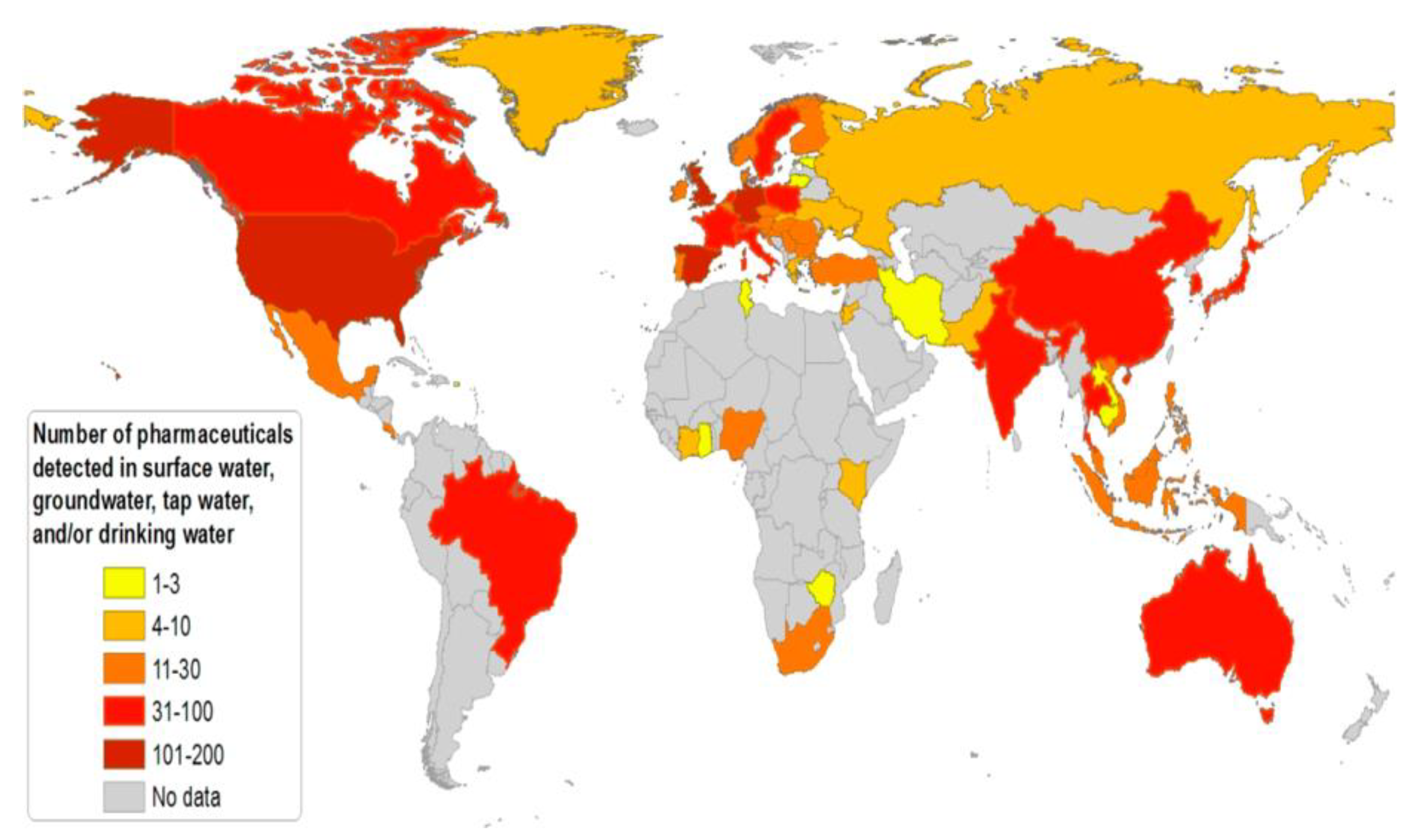
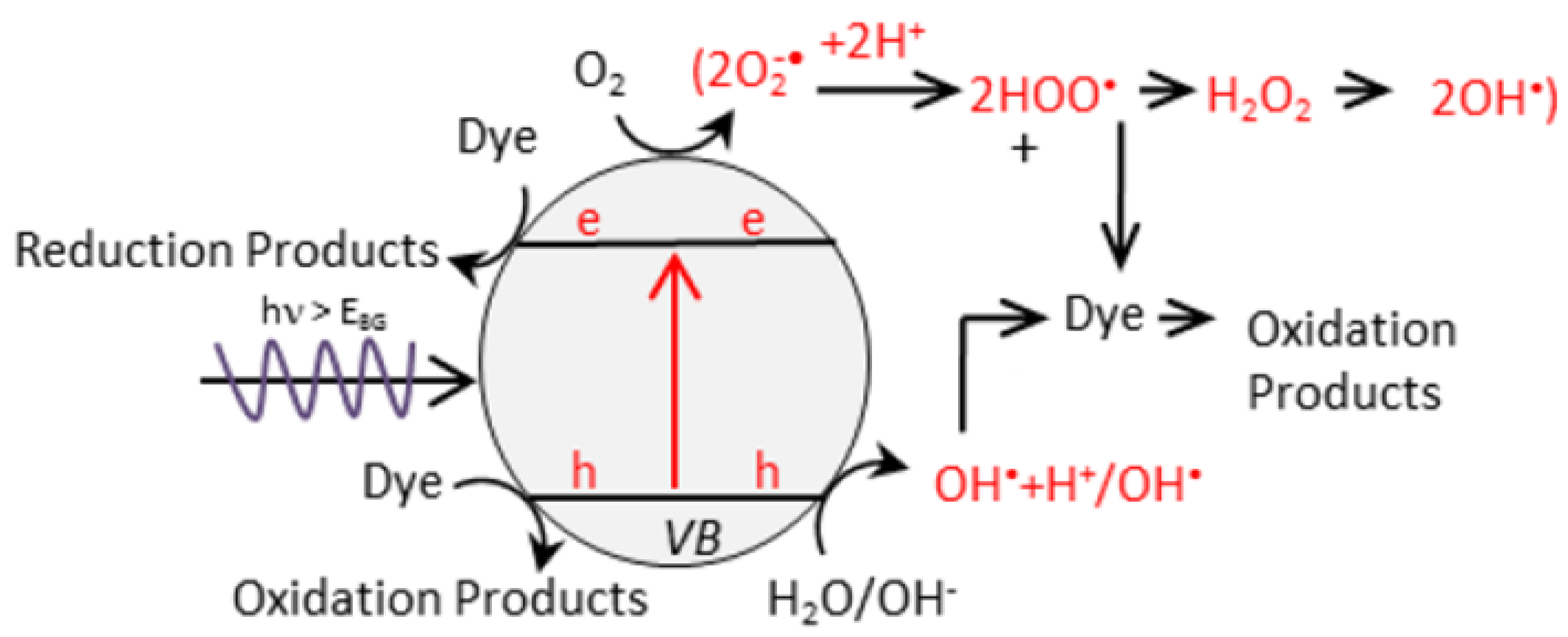
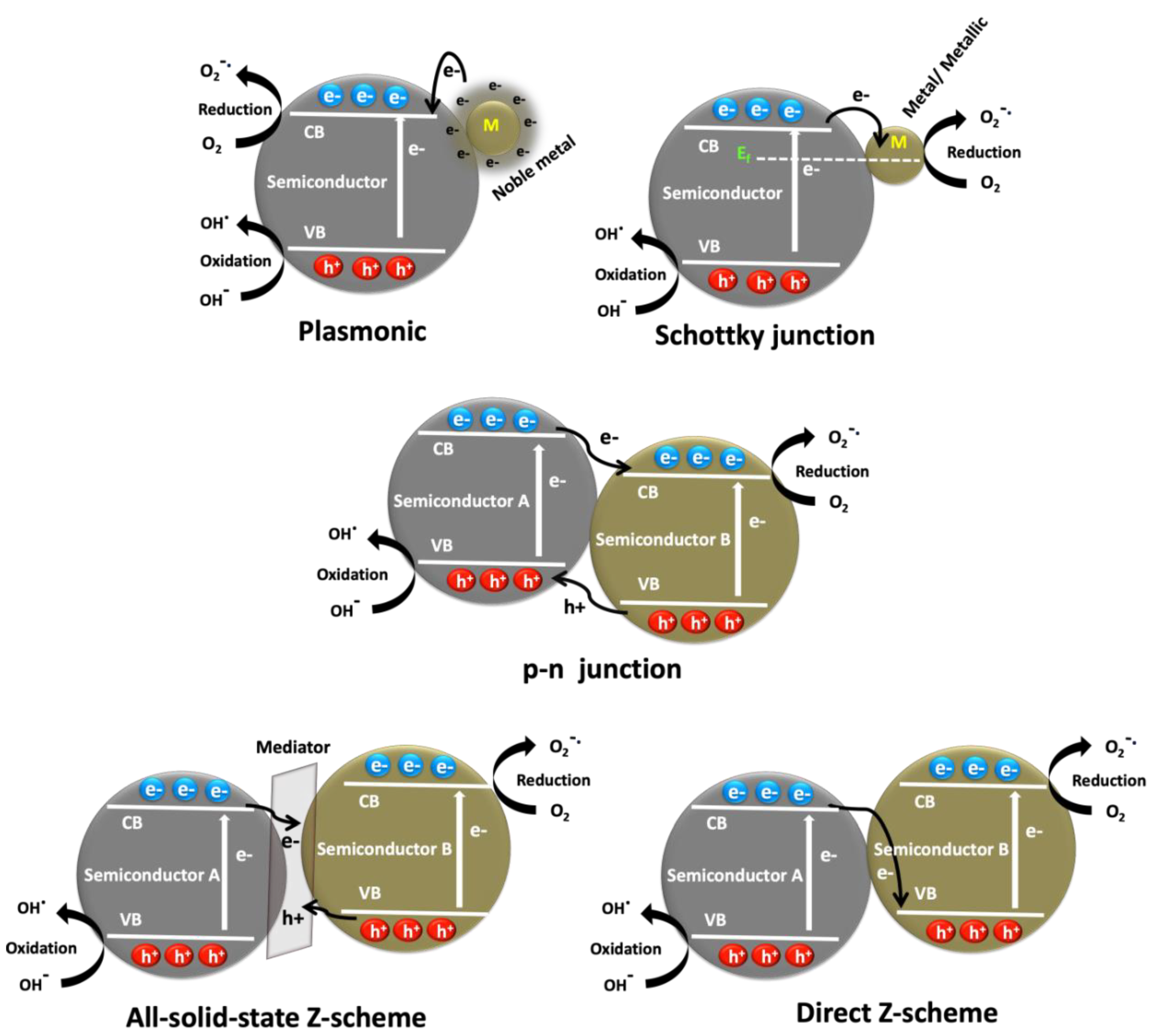
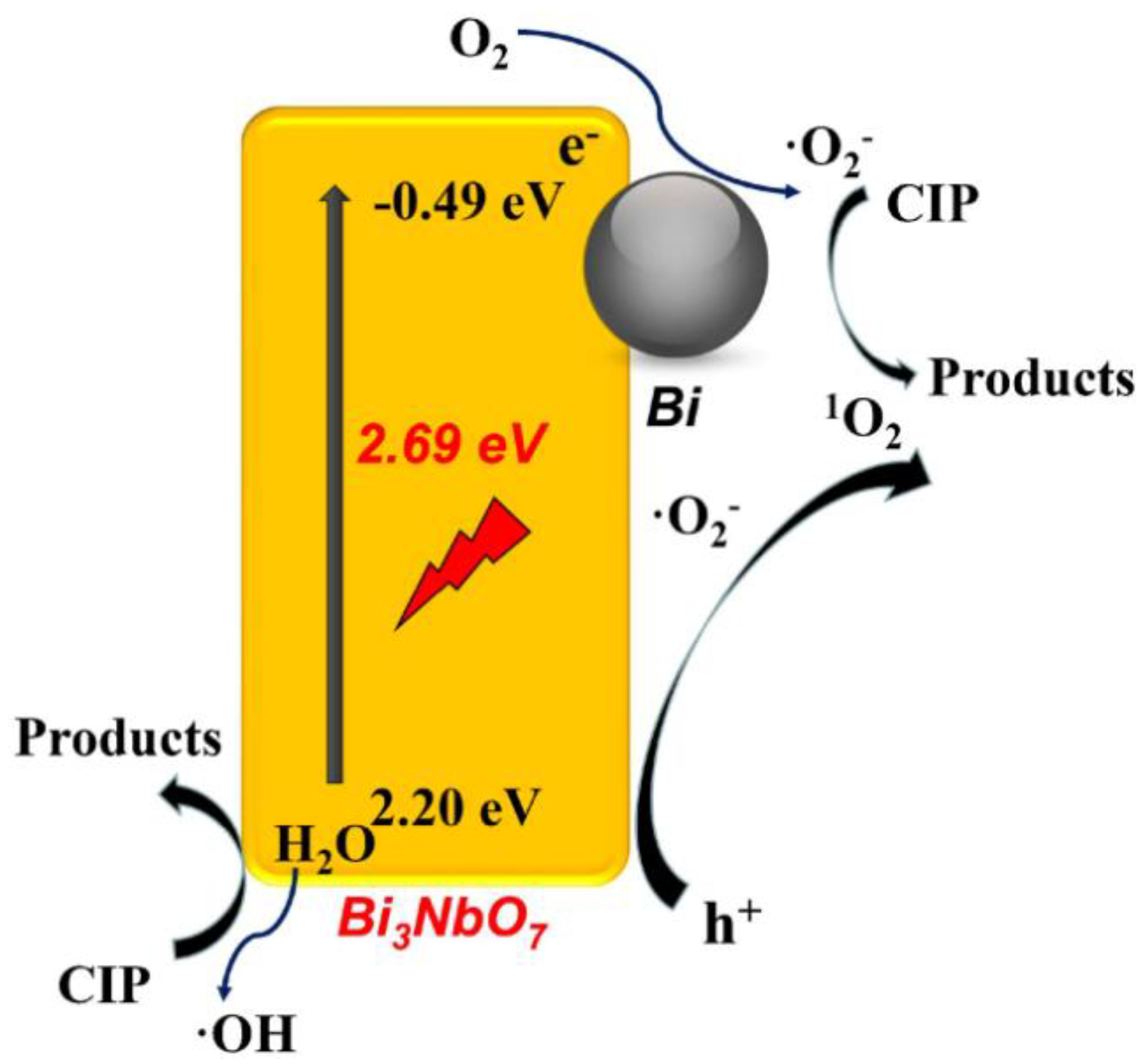
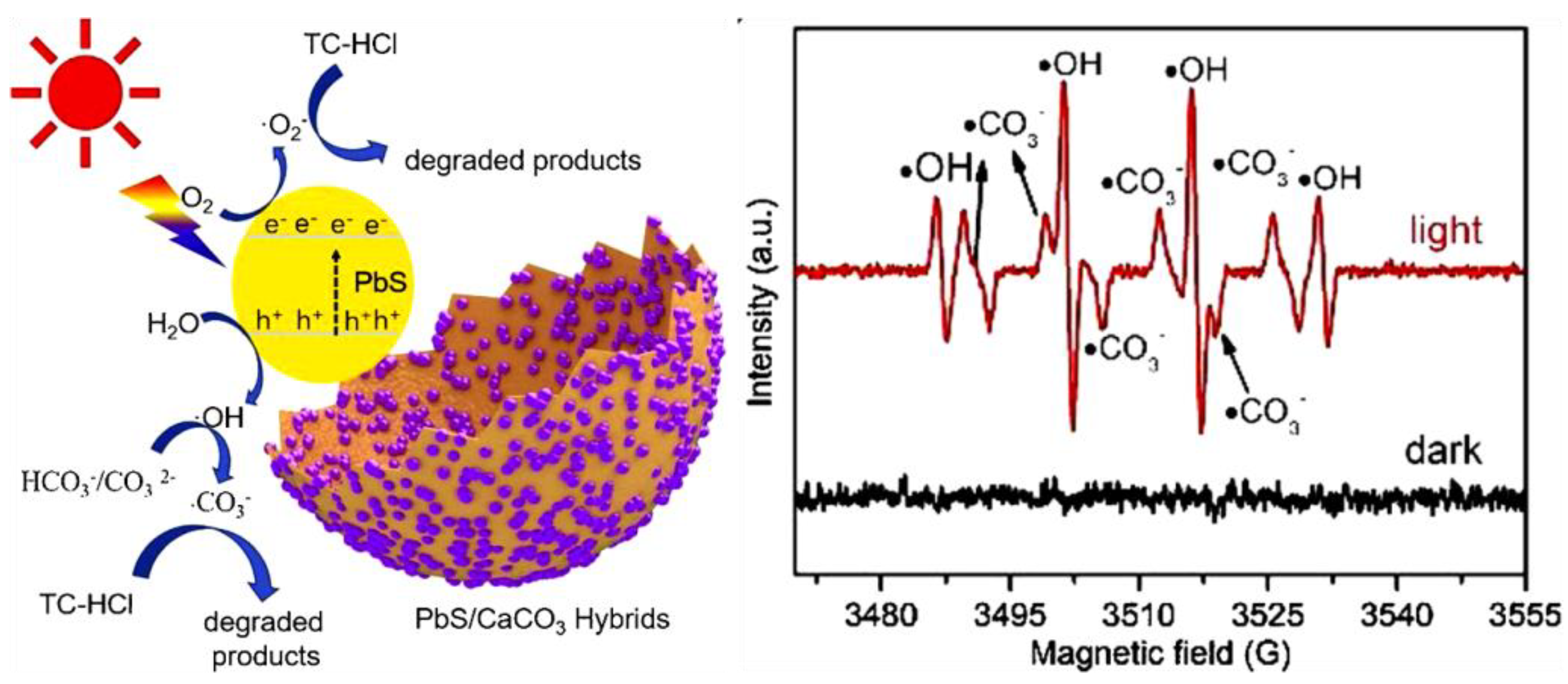
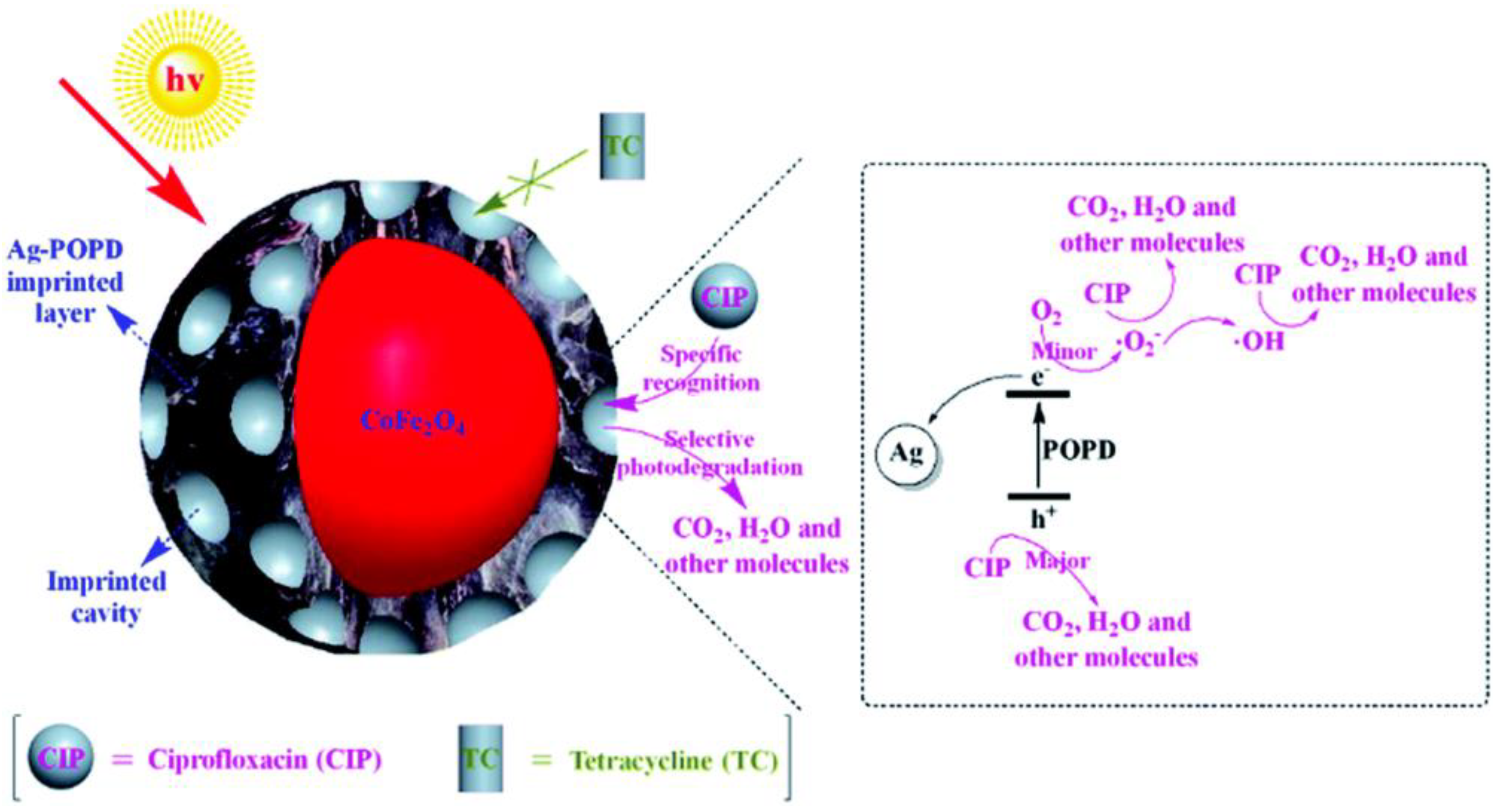
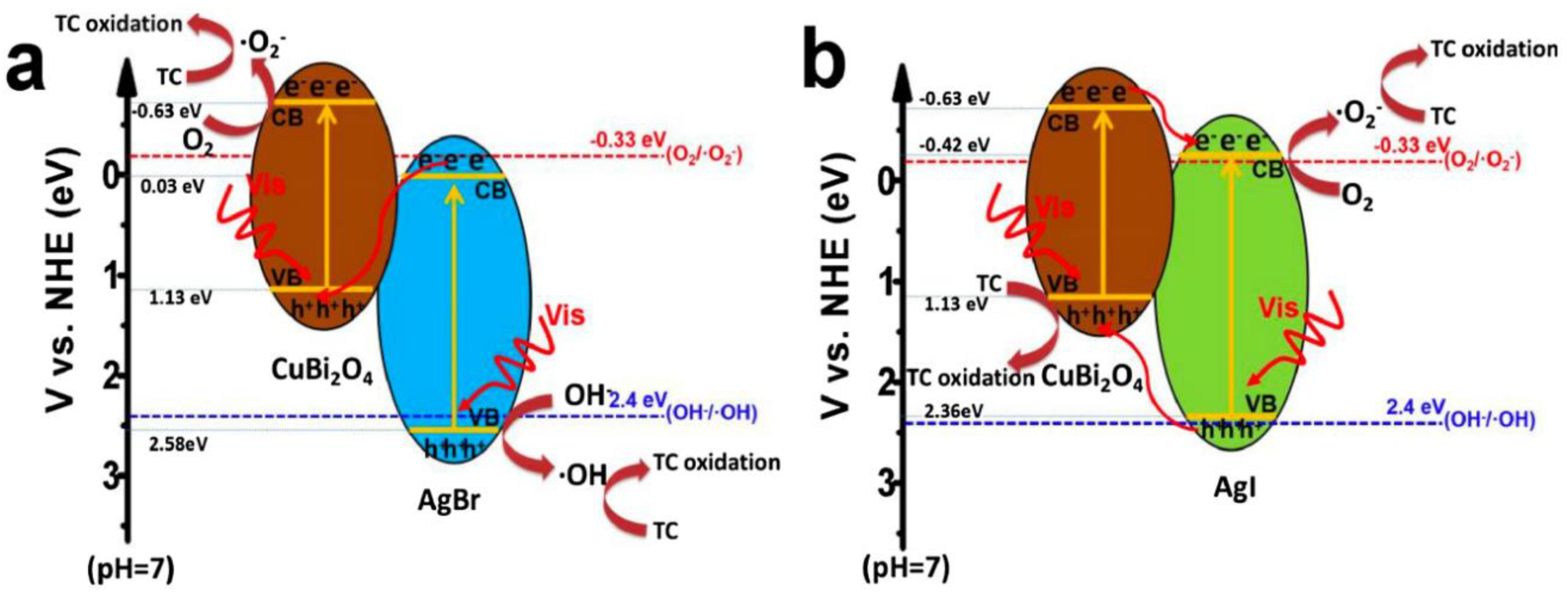
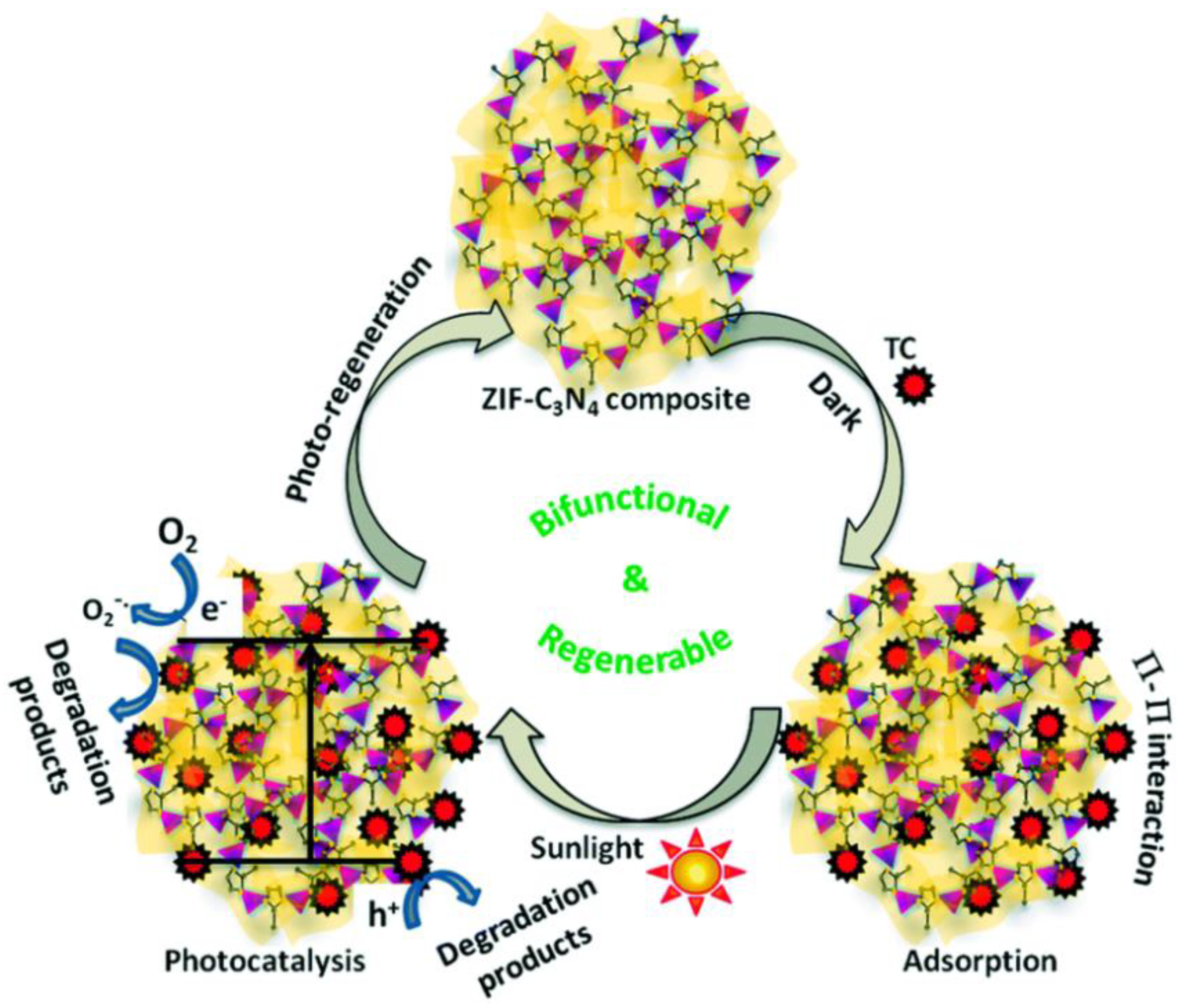
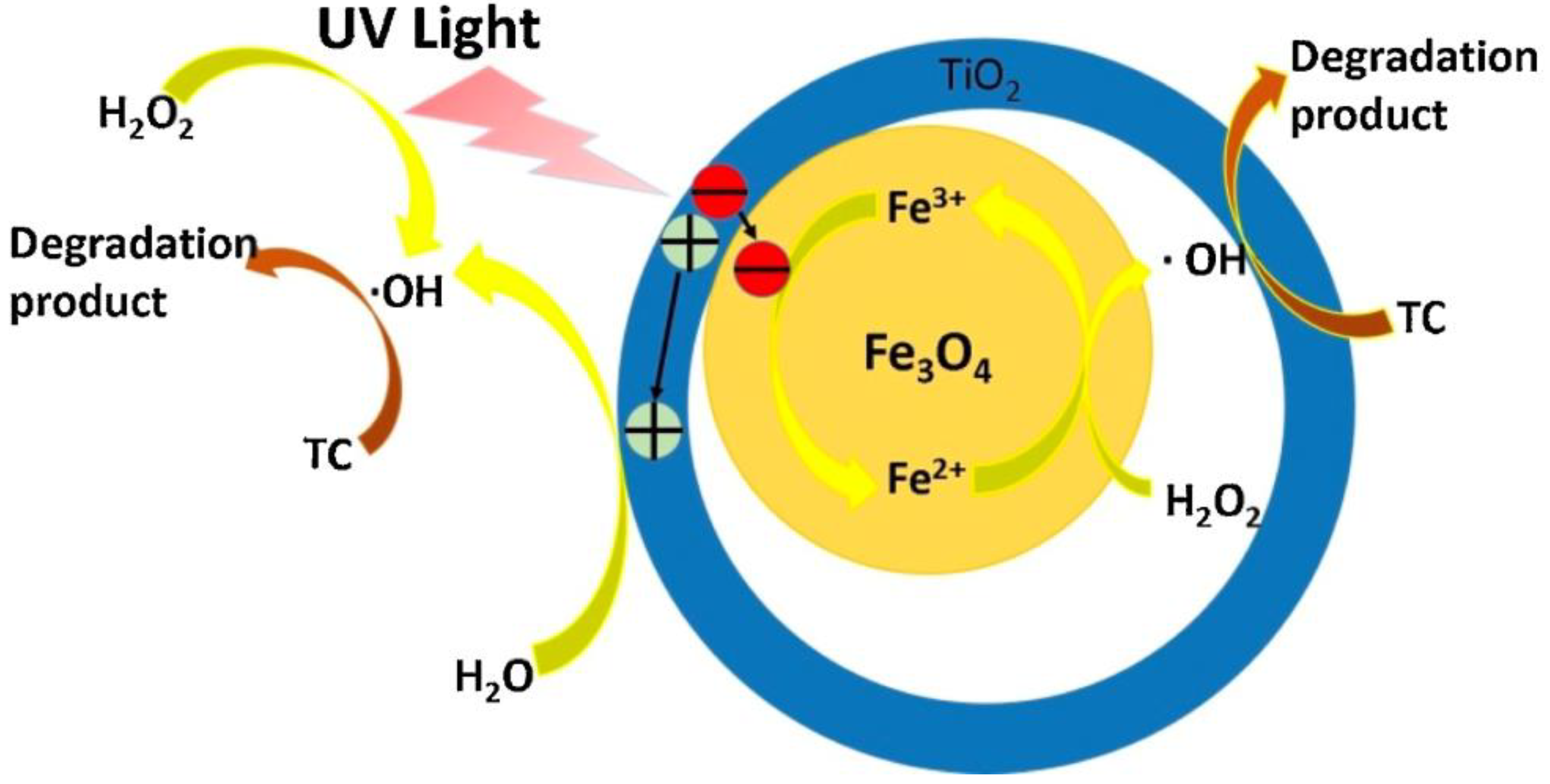
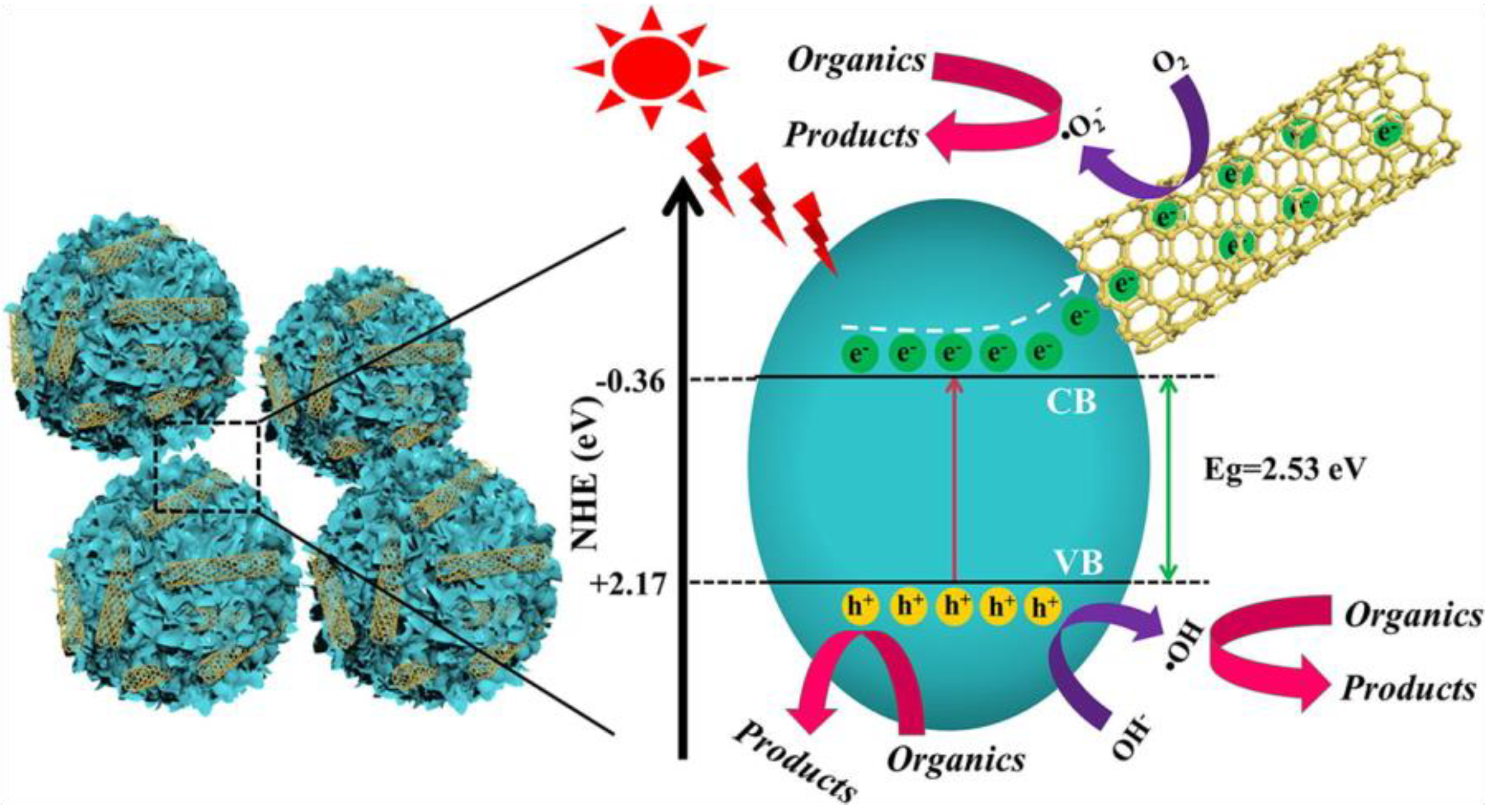
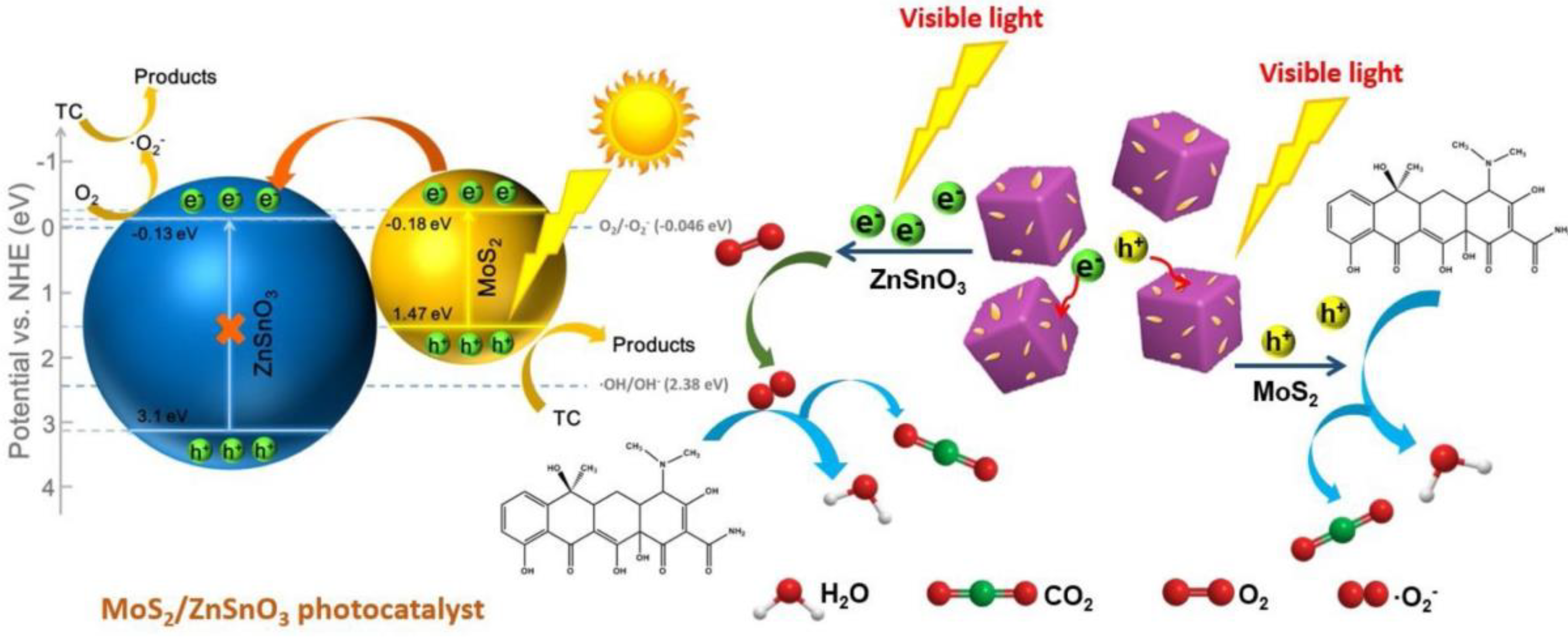
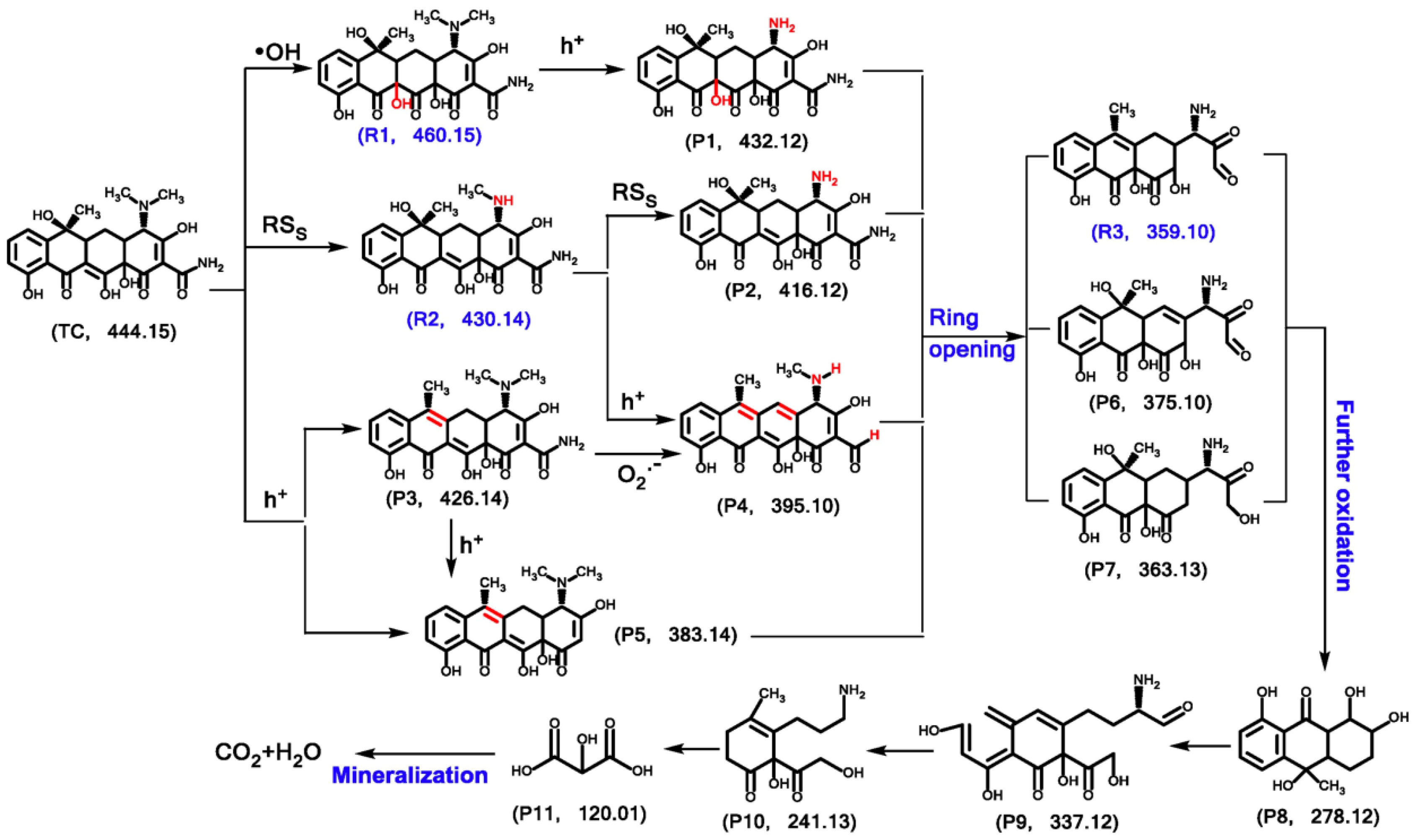
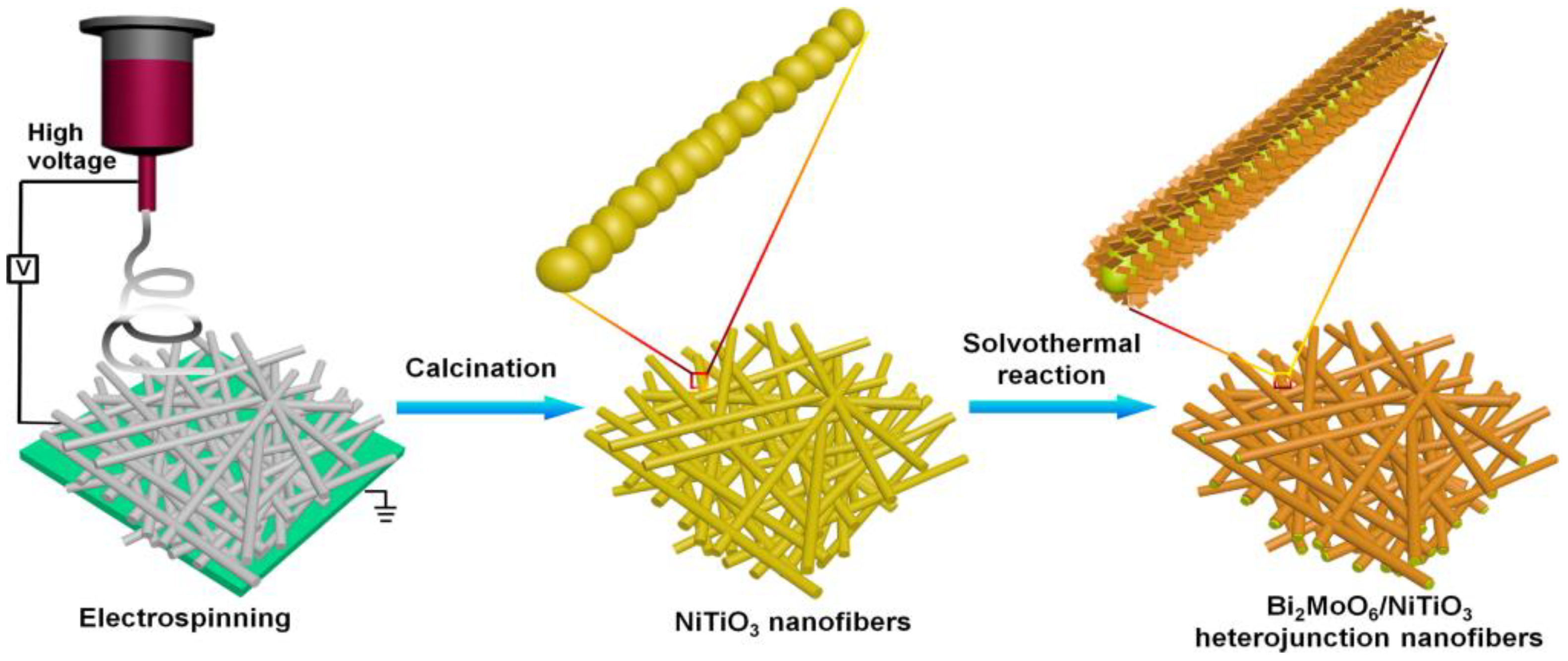
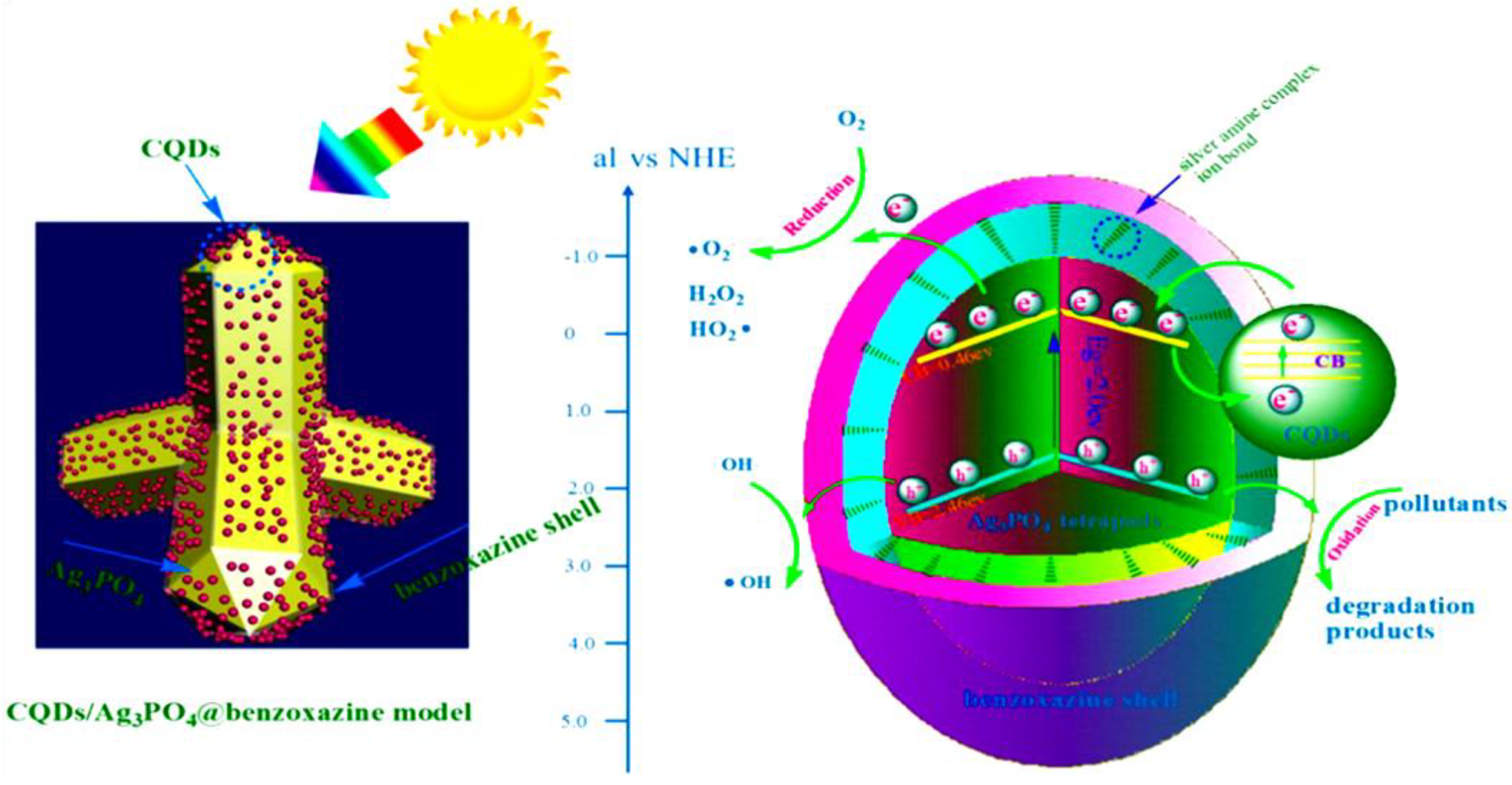

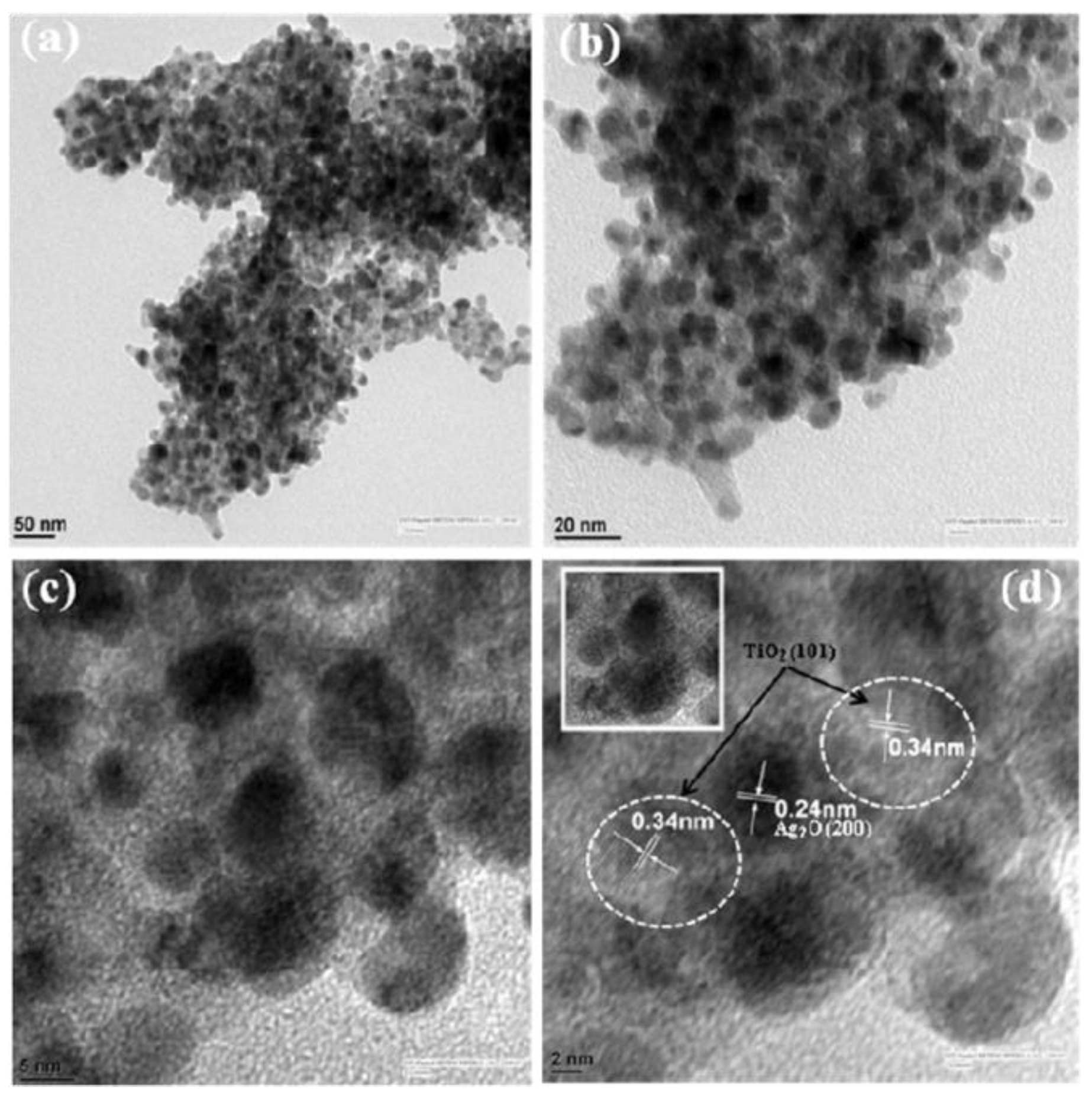
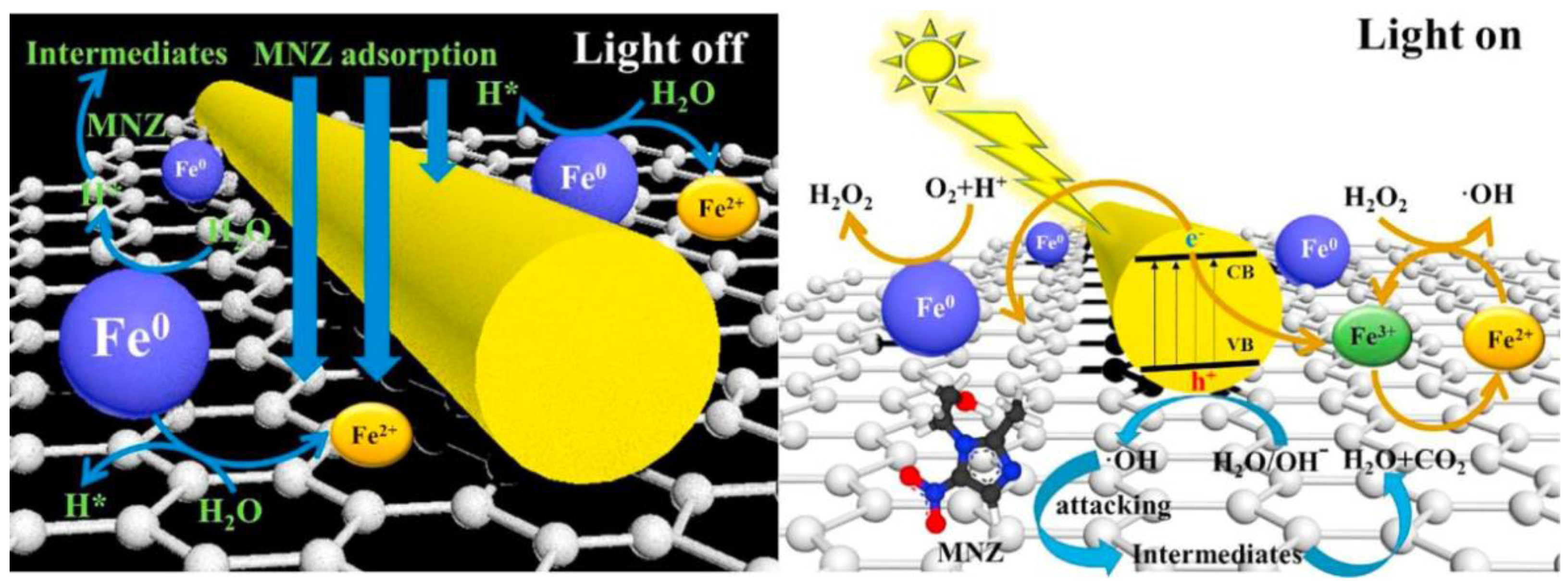
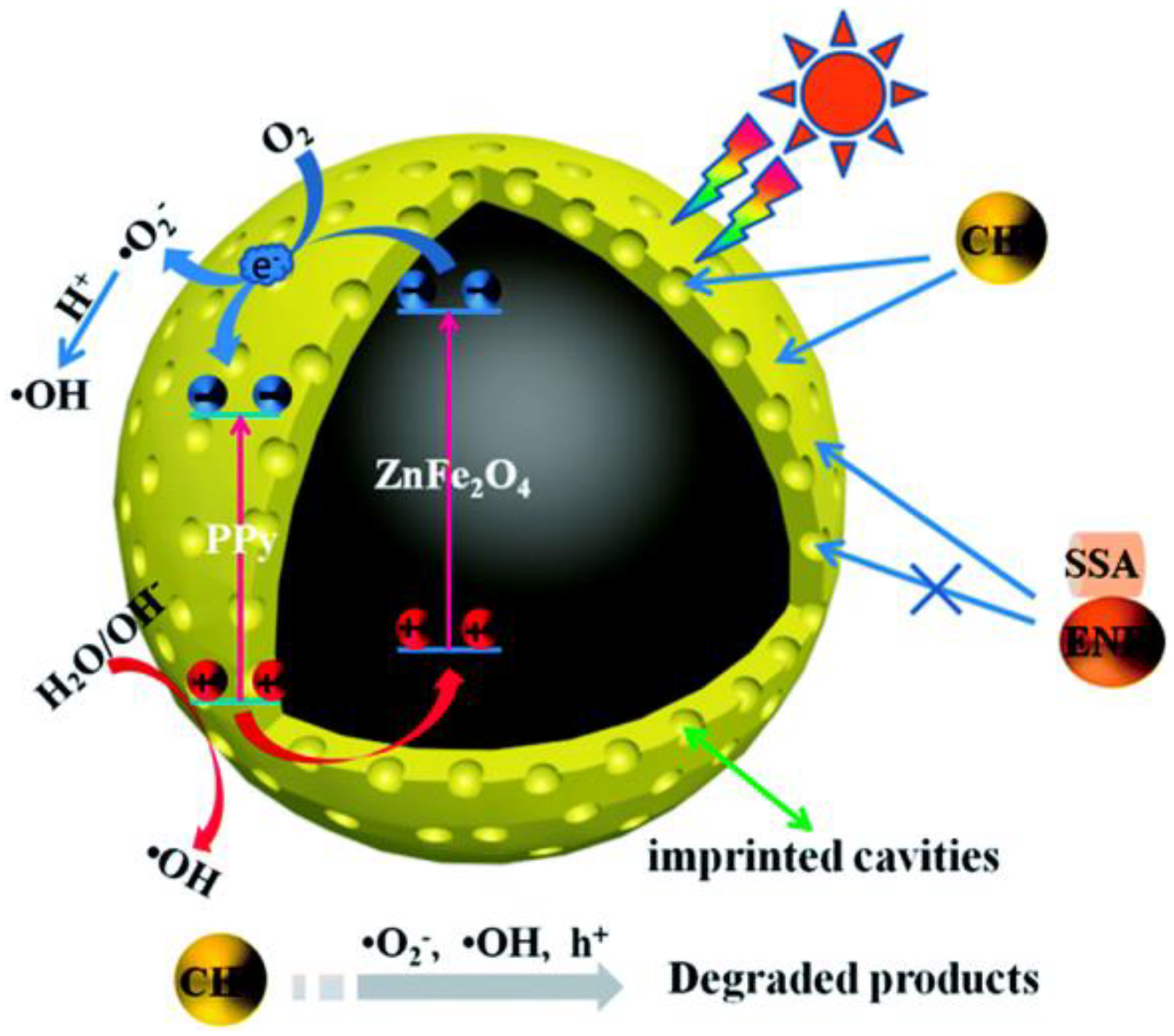
Publisher’s Note: MDPI stays neutral with regard to jurisdictional claims in published maps and institutional affiliations. |
© 2021 by the authors. Licensee MDPI, Basel, Switzerland. This article is an open access article distributed under the terms and conditions of the Creative Commons Attribution (CC BY) license (http://creativecommons.org/licenses/by/4.0/).
Share and Cite
Rokesh, K.; Sakar, M.; Do, T.-O. Emerging Hybrid Nanocomposite Photocatalysts for the Degradation of Antibiotics: Insights into Their Designs and Mechanisms. Nanomaterials 2021, 11, 572. https://doi.org/10.3390/nano11030572
Rokesh K, Sakar M, Do T-O. Emerging Hybrid Nanocomposite Photocatalysts for the Degradation of Antibiotics: Insights into Their Designs and Mechanisms. Nanomaterials. 2021; 11(3):572. https://doi.org/10.3390/nano11030572
Chicago/Turabian StyleRokesh, Karuppannan, Mohan Sakar, and Trong-On Do. 2021. "Emerging Hybrid Nanocomposite Photocatalysts for the Degradation of Antibiotics: Insights into Their Designs and Mechanisms" Nanomaterials 11, no. 3: 572. https://doi.org/10.3390/nano11030572
APA StyleRokesh, K., Sakar, M., & Do, T.-O. (2021). Emerging Hybrid Nanocomposite Photocatalysts for the Degradation of Antibiotics: Insights into Their Designs and Mechanisms. Nanomaterials, 11(3), 572. https://doi.org/10.3390/nano11030572







